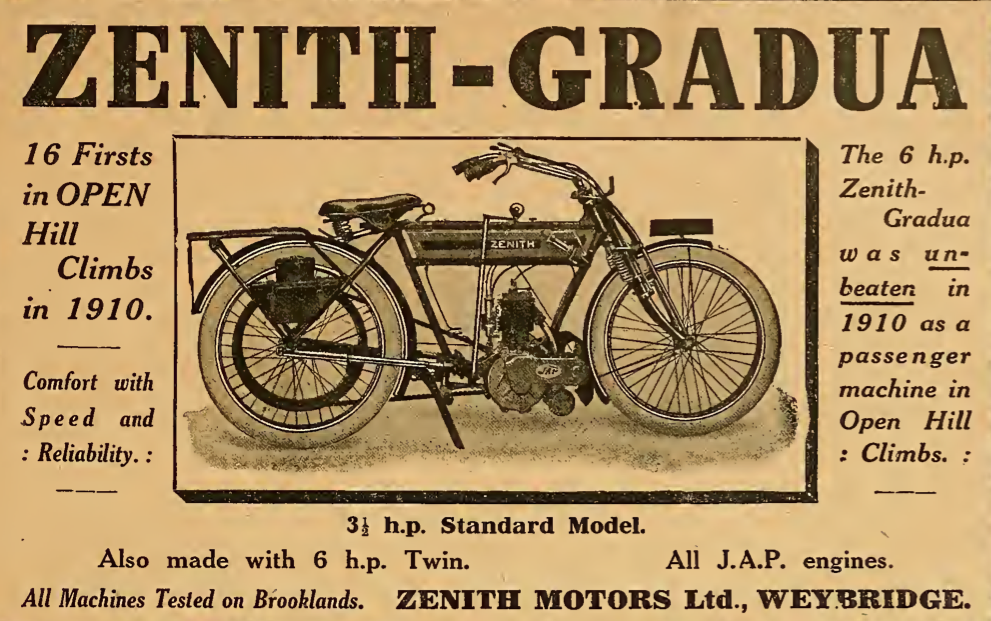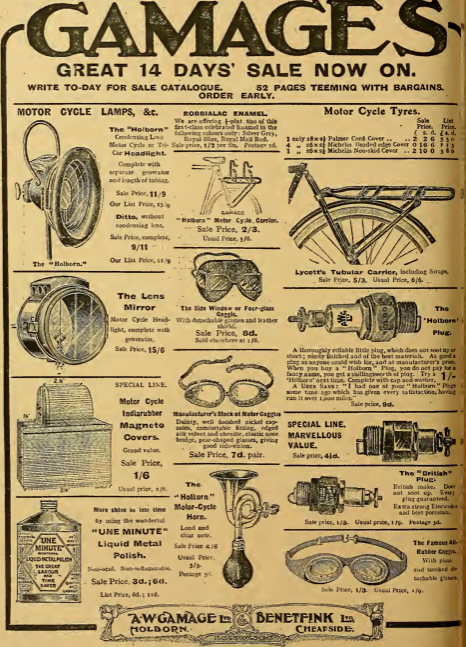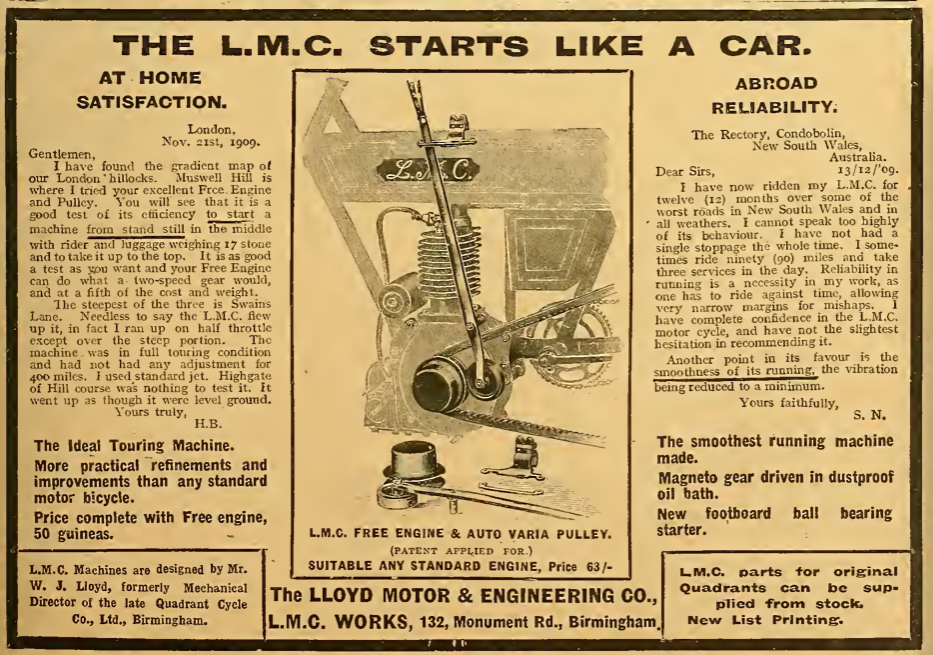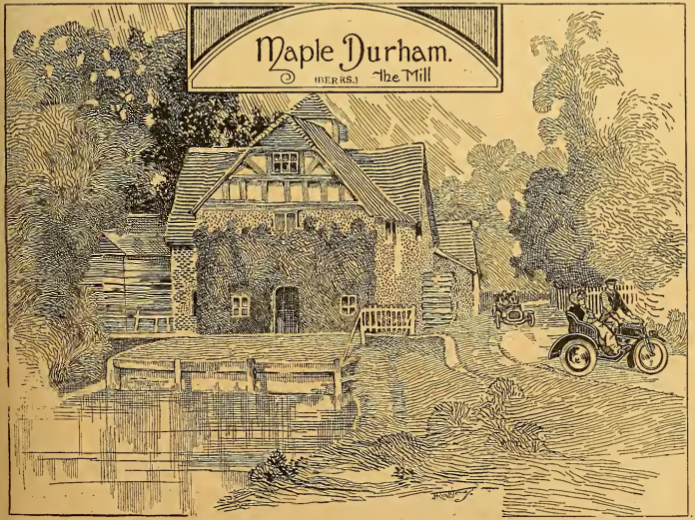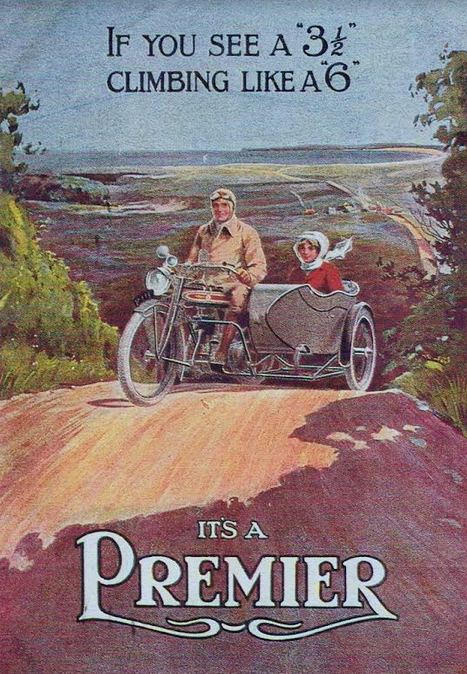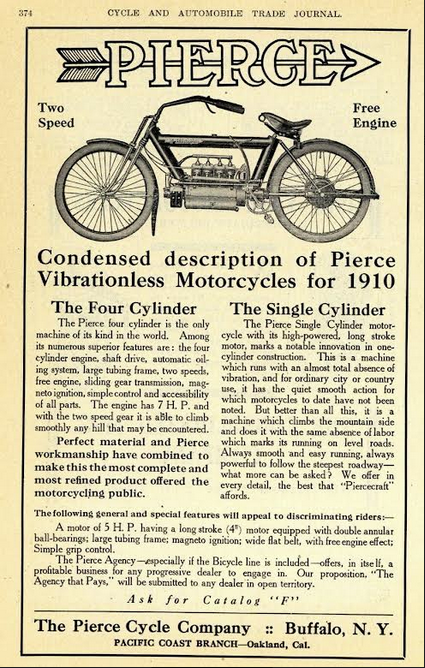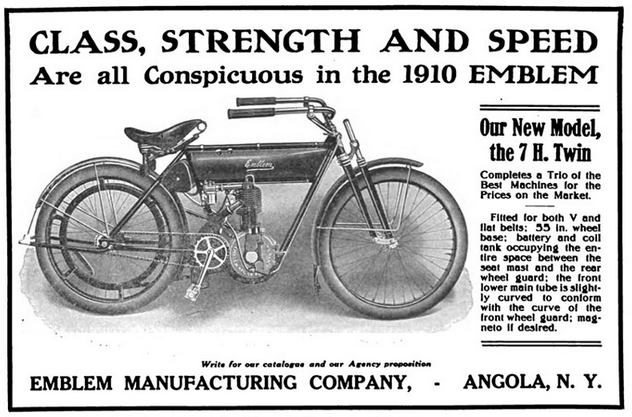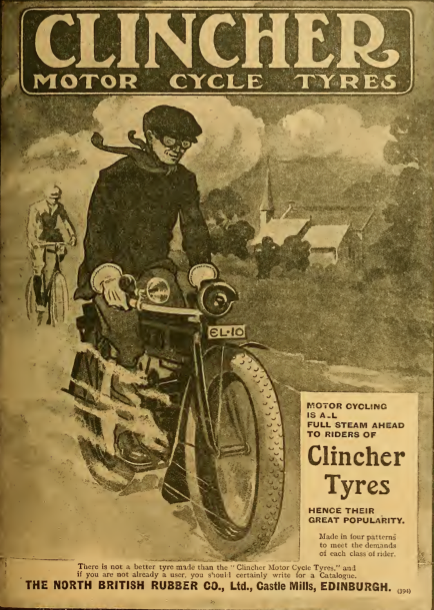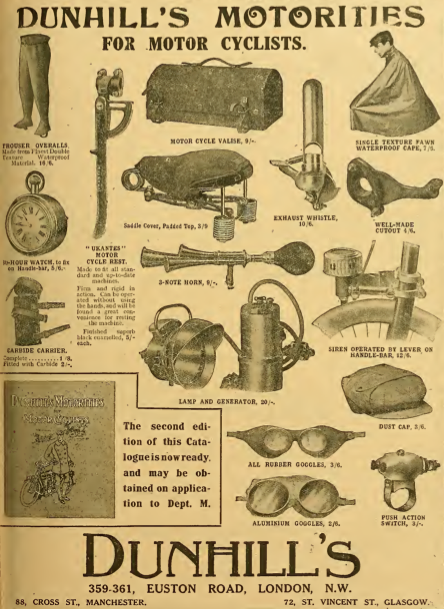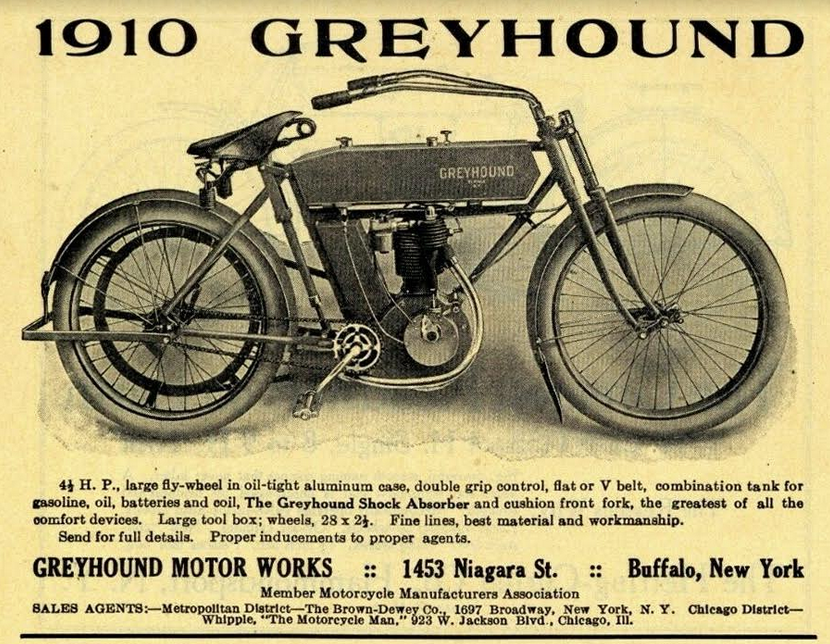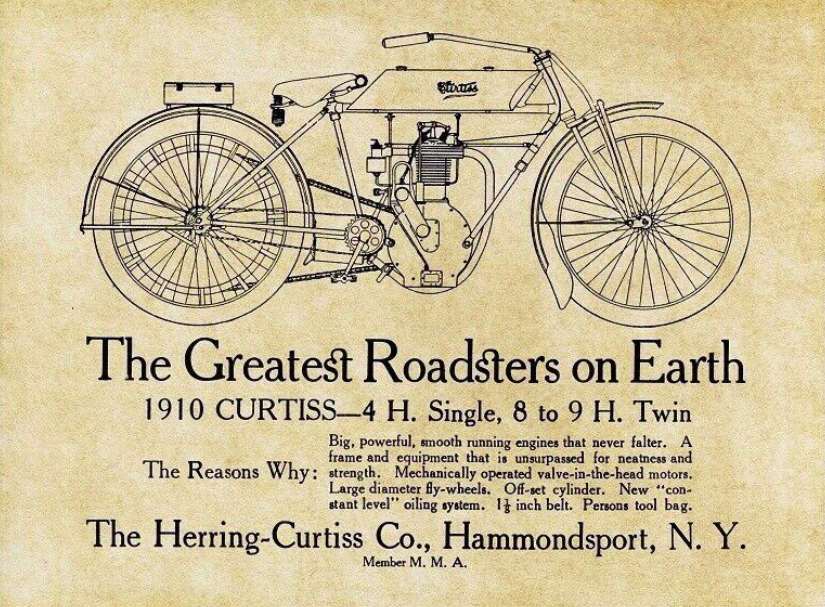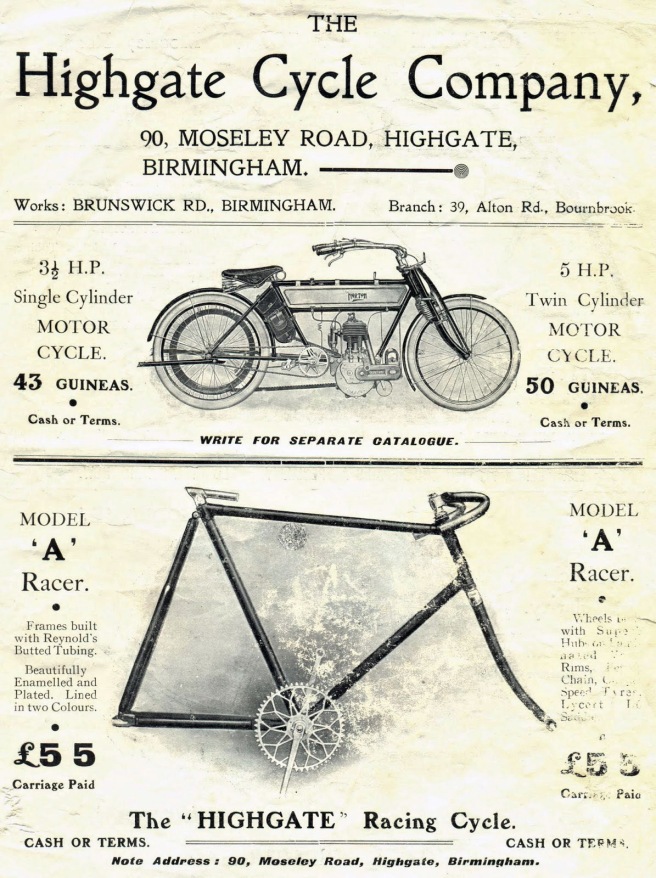
THE FIRST COMPLETE BSA motorcycle was the highlight of a lunch held at the Small Heath Works on Wednesday 19 October. It made its public debut at the first Olympia show devoted exclusively to motor cycles (393 of them, breaking the previous record, of 375, set at the 1903 Stanley Show. Nearly 60% of the bikes had pedalling gear, 337 had belt drive, 277 were singles. They were examined by 80,000 enthusiasts). According to the show report: “There is no radical departure in the design, for the new BSA is a 3½hp helt-driven model with 85x88mm (499cc) engine, and the aim of the designers has obviously been to adopt well-tried principles. The frame is low and, well designed, the different parts neatly distributed, and the tout ensemble presents a pleasing and workmanlike appearance. We have had the pleasure of a brief spin on the new BSA, and what impressed us more than anything else was the flexibility of the engine: it is possible to control the machine at a slow walking pace, thanks to the exceptionally heavy flywheels. The engine is very silent with the cut-out closed, and the engine is readily responsive to the throttle. The low frame, long handle-bars, and convenient position of the footrests prove that the rider’s comfort has been well studied; in fact, we felt quite at home on the machine from the very first. In grease the machine was proved to be very stable with rubber-studded tyres, and the hand-applied front rim brake and foot operated belt rim brake left nothing to be desired in the way of braking power. There will be two models of BSA machines. One, the ordinary standard direct-driven machine as we have just described, whilst the other will have a free-engine clutch embodied in the rear hub. It goes without saying that the BSA motor cycle is beautifully finished throughout.” Yours for fifty quid, or £56.10s with the clutch.
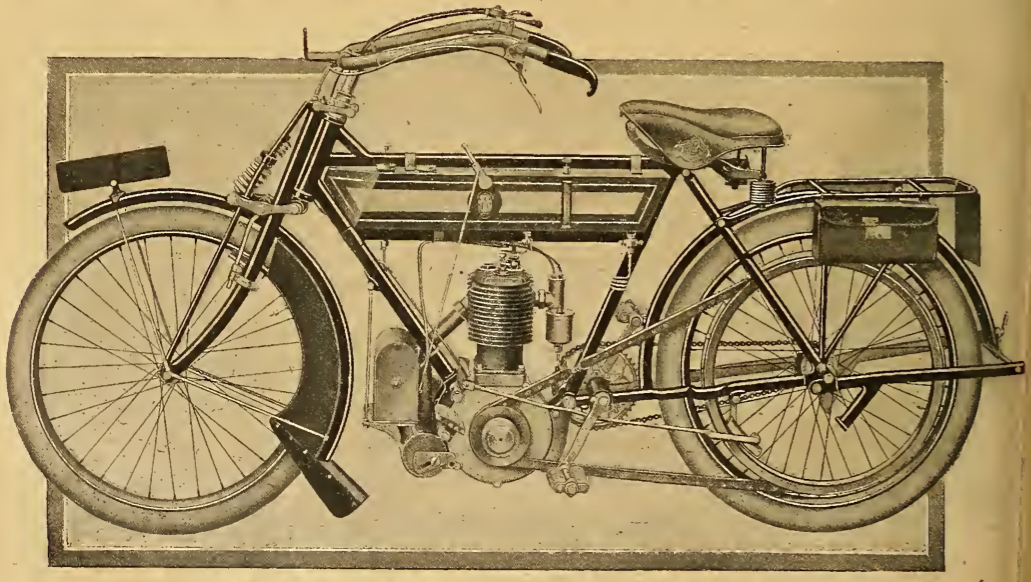
OTHER DEBUTANTES AT OLYMPIA included AJS AND RUDGE. AJS showed a 2½hp 298cc sv single-speeder with belt drive (the capacity met the new Junior TT limit of 300cc). For riders with deeper pockets it could be supplied with a clutch, two-speed gearbox and chain drive. The Stevens boys also showed a prototype 3½hp V-twin. Rudge Whitworth with a 499cc ioe single. The Motor Cycle reported: “We had an opportunity early this week of a trial of a few miles on the new Rudge-Whitworth motor bicycle. As far as the engine is concerned, it is not the actual type which will be eventually marketed, but the broad design will remain the same. The spring fork is a neat construction of oval tubing, the spring portion being connected to the steering column by means of parallel joints. One coil spring only is used, and that is enclosed in a tube. The frame is exceptionally low, and the riding position we found to be verv comfortable; the spring fork also absorbed all road shocks, and in the short distance ridden was most satisfactory. The stand is operated by a spring; when the machine is wheeled forward it assumes its normal position, being held in place by the tension of the spring. The engine has a cubical capacity of 499cc…The valves are located in front, the inlet being of the overhead mechanically operated type…The management and staff of the Rudge-Whitworth Co are to be congratulated on the smartness with which their motor bicycle has been designed and built, as the drawings, patterns, and building of the machine have only occupied one month from the time it was put in hand.”
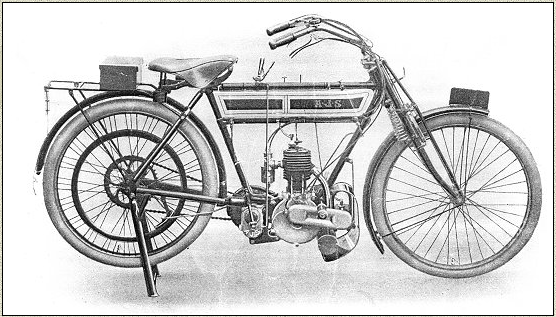
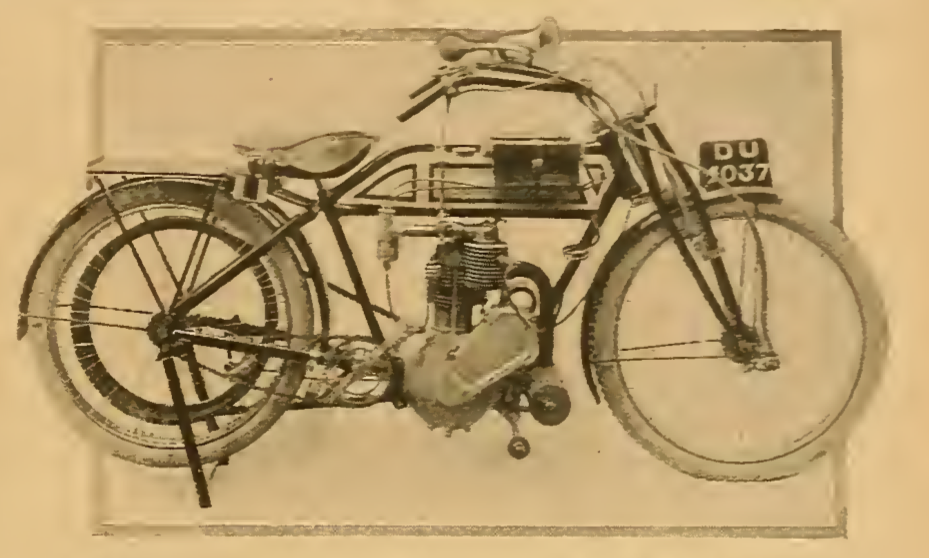
THE NEW YORK show featured 89 models: 56 singles, 31 twins and two fours. Automatic inlet valves still outnumbered mechanical by 51:38; 48 had magnetos, 26 relied on batteries and 15 came with an option. And belts outnumbered chains at 63:22, with fours shafties.
THE FIRST SUPERCHARGED engine was developed by the Murray-Willat Company and built by the American Motors and Aviation Company. The 2.4lit six-pot two-stroke rotary developed 30hp.
THE SENIOR TT limit stayed at 500cc for singles but was cut from 750 to 670cc for twins, whose ever increasing speeds concerned the organisers. Matchless duly modified their twins and Charlie Collier led brother Harry home at an average speed of 50.63mph ahead of Billy Creeyton’s Triumph one-lunger. Harry Bowen set a lap record of 53.15mph on his BAT twin before crashing on wooden banking installed that year at Ballacraine to protect riders from a jagged wall. No doubt he appreciated the irony. There’s a full report of what happened, including bikes and riders in flames, crashes, comments and a cocky farmer who tried to delay the start in the 1910 Features section.
THE FIRST DRIVE-IN petrol station with island pumps opened in Detroit; the Los Angeles Police Department put eight motorcycle cops on the street.

“Several correspondents recently have mentioned the desirability of having means to enable the rider to keep the machine upright without the necessity of putting one’s feet in the mud. Barsby’s Patent Safety Footboards achieve this, and considerably more, as, if combined with a clutch, this device enables a motorcycle to be driven anywhere and under any condition of road or weather, exactly like a motorcar. It is so arranged that when the right footboard is depressed, the clutch is withdrawn, and the machine can remain stationery with the engine still running. By a particular adjustment of the clutch lever, it can be left so that when the footboard is down, the clutch is not quite free, but is acting as a slight brake on the engine to prevent it racing. The device also makes a very good stand. When the rider stops, he can engage two catches, which keep the boards down and allow the rider to dismount and leave the machine upright. Handle starting from the bottom bracket is provided for, and the device can be fitted by anyone to any machine, as there are only two clips to fix. Absolute immunity from sideslip under any conditions is claimed by the inventor, Mr W Barsby, 6 Cecil Court, Charing Cross Road, WC. The machine has been ridden on the London streets for the past 12 months, with full satisfaction. It is fully patented, will shortly be on the market and meanwhile can be inspected at the above address by any of the readers of Motor Cycling.”

“THE JACK NO-SKID, 27s 6d from W Hayes of 44 Ball’s Pond Rd, London N, is claimed to absolutely prevent sideslip. It comprises two small wheels each side of the driving wheel which can be be put in and out of engagement with the road by means of a Bowden wire. It is claimed to take less than 5min to fit and also works as a stand.”
A GROWING NUMBER of manufacturers offered ‘free engine’ clutches in the rear hub, wheel pulley or engine shaft. As well as allowing the rider to sit in trafic with the engine running this was a step towards the use of countershaft gearboxes.
THE MILITAIRE, described by the Blue ‘Un as “an American novelty” was an interesting attempt at a two-wheeled car. Its manufacturers claimed that, after two years’ development, it was “five years ahead of the motor cycle world, from every point of view.” Noteworthy features included hub-centre steering; coil springs up front and quarter-eliptic springing at the rear; wooden-spoked artillery wheels; ‘idler wheels’ controlled by the lever next to the seat; and “friction drive”, which was said to give a range of gearing, from 30 to 1 on low to 3 to 1 on high, with 10 to 1 in reverse. The 480cc single-cylinder air-cooled engine was encased in a polished casing which was open at the top. Air was drawn down by “a highly developed sirocco blower in the flywheel”; the cooling system was claimed to be “equally efficient with the machine travelling or standing”. Later models came with handlebars and a 1,306cc ohv four-pot lump. The Militaire was in production for six years by no less than eight companies though fewer than 200 were completed.

AN ACCESSORY manufacturer who had spent some time in America reported: “Barring the Indian, which is easily the most popular mount in the States, they are, frankly speaking, a disappointing lot—very much where English machines were four or five years ago. Gaudy coloured enamels and ungainly tank and frame outlines are, of course, mere matters of taste, but both in constructional details and general specification they are as a class vastly inferior to British types. Luggage carriers are conspicuous by their absence, perhaps owing to the small amount of genuine touring work possible in most localities. Very often no stand is provided, and some of the few stands I saw were worse than useless. No attempt is made to shield the rider from bad weather; even a front mudflap seldom figures on a standard mount. The engine is often attached by a light, flimsy clip, and in particular the steering heads are often short and not set nt the best steering angle. The carburetter is fitted anywhere—on some machines it is in front of the cylinder, where it gets frozen itself and screens the engine; on others it is at the back, coupled up by a long meandering pipe. The control is almost universally by twisting grips with rod or linkshaft connections, and struck me as considerably inferior to our flexible wires. Of course, the majority of American makers have never had to cater for reliability in the same sense that our makers regard it, for most of their customers only use their
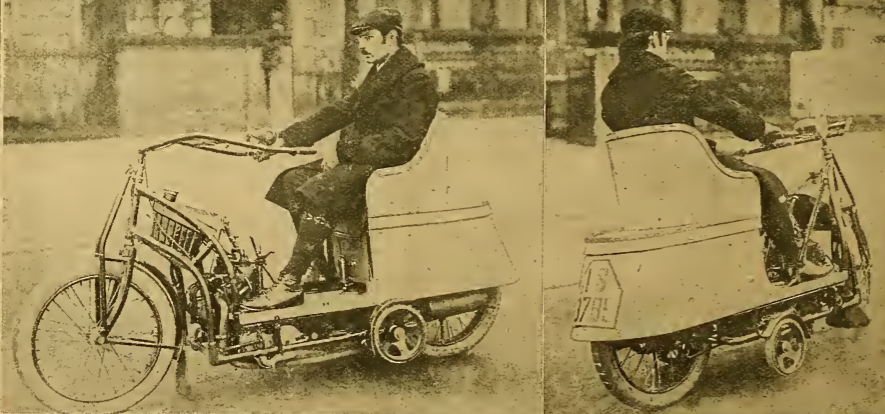
machines for short excursions to suburban resorts. They are catching up fast, and in two or three years will most probably be as good as ours. Several makers have bought samples of our best machines, and are copying their strong points. I found many makers quite candid in admitting that we were streets ahead of them.” But he added: “The American riders are obviously very fine riders, for, in spite of being so handicapped by the majority of their machines, they put up startling performances on the racing track, and the percentage of non-stops in their reliability trials is exceedingly good.” Earle Ovington of the Federation of American Motorcyclists mounted a vigorous refutation on all fronts; with reference to reliability trials, he accepted that American trials were
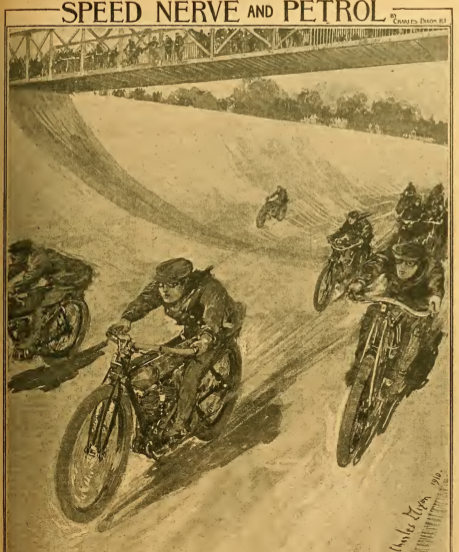
generally shorter but added: “As far as strenuous riding is concerned I do not think British riders really know what it is. On our endurance runs we often strike sand six or eight inches deep for many miles at a time, hills several miles in length with a very rough road surface, and it is not at all unusual for a motor cyclist to be thrown violently from his machine by being forced to ride over a rock larger than his head.” The US magazine Motorcycle Illustrated was clearly not impressed: “We were stupified…Was there anything uncomplimentary that he had left unsaid? He regarded with a feeling akin to scorn everything appertaining to the manufacture of motorcycles in this country.” But Motorcycle Illustrated gleefully added: “Only a few months after that stinging broadside had been banged off the typewriter, an American machine has obtained the highest percentage in the ACU Quarterly Trial. That machine had already demonstrated its possession of speed, but your hard-headed subject of King Edward persisted in scouting the very idea of its proving itsef reliable…their claims of all-round superiority are much too amusing to be at all intolerable.”


LIKE BIRMINGHAM Small Arms, Miyata Small Arms went into the bike business, developing a flat twin for the Tokyo Metropolitan Police. It flopped, so Miyata copied a 3½hp Triumph engine and supplied the cops with 16 bikes dubbed Asahi (Morning Sun). A high retail price put off civilian customers.
FRANCE WAS becoming addicted to lightweights such as Terrot’s ‘motorette’ featuring split-pulley variable transmission.

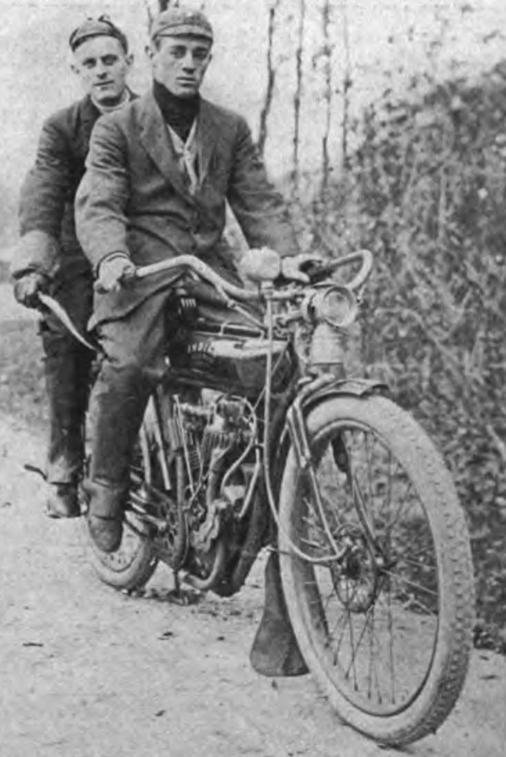
BEATRICE LANGSTON, Mabel Hardee and Muriel Hind were among plucky gels making a name for themselves in trials.
THE LONDON-based Silvertown Rubber Company added carbon black to white rubber to make more durable tyres.
A $10 TAX IN Chicago elicited a no-holds-barred editorial in the US Motorcyclist Illustrated: “This is another example of modern piracy. In the old days, a freebooter who wanted to live without industry applied to Captain Kidd or enlisted under the banner of Robin Hood, Dick Turpin, or some other merry cutthroat. Now they simply go into public life and become aldermen… The Chicago riders and trade have banded together and engaged a lawyer to reopen this matter. This tax is simply outrageous…”
THE ACU’s TOURING Department began to register approved ‘motor cycle repairers’ throught the country for the benefit of touring motor cyclists in need of help. More than 90 applied within the first week.
THE LAW ALLOWED motor vehicle owners to ‘licence’ their vehicles in the county of their choice. Some riders were taxing their bikes outside their home counties to protest against persecution by local courts and poor road maintenance.
LONDON-BASED Standard Alloys came up with an aluminium solder for home use. The Motor Cycle reported: “Readers will be interested to know that on the occasion of the AL solder being demonstrated at these offices one of our staff made a very fair job of soldering two pieces of aluminium together at the first attempt…We were shown two pieces of aluminium tube joined together end to end so strongly that a powerful man could not separate them.”
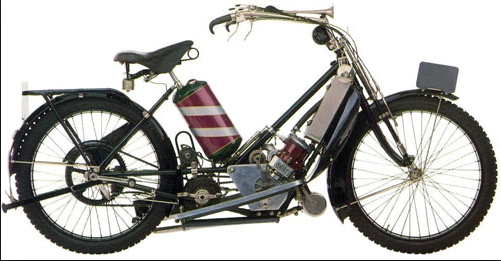
THESE WERE technical times. The Motor Cycle published a feature by James Norton in favour of long-stroke engines. Alfred Scott refuted this view with four pages of technical argument supported by graphs, diagrams and equations. ‘Pa Norton’ cheerfully waded in with another two-page disquisition of his own, concluding: “I have now dealt with the principal points of Mr Scott’s criticism, and shown that his arguments are not favourable to the short-stroke engine, but really serve to strengthen my original case for the long stroke.” Cue Mr Scott’s return salvo: another two pages of closely argued technicalities in support of short-stroke two-strokes.
MOST ‘PASSENGER’ motor cycles carried two people; family man A Powell of West Bridgford, Notts needed to carry five. He had a Chater-Lea Number 6 frame with an 8hp MOIV JAP twin, handlebar controls, automatic lubricator, JAP free-engine clutch, handle starter and dual ignition (Bosch magneto and Fuller’s battery/coil). To this he attached a flexible pattern Montogomery sidecar, fitted on the right of the bike, with an extended rear section to take a brace of nippers and a large under-floor luggage box.

“WE REGRET to have to announce that OC Godfrey, the holder of the single-cylinder hour record, is laid up in a nursing home in Hampstead with a broken leg. The fons et origo mali is not motor cycling, but roller skating—a far more dangerous form of amusement.”
“EDISON’S WONDERFUL storage battery is once again the subject of newspaper comment. It is said that on a recent trial the batteries propelled a tram-car laden with people quite satisfactorily, and the cost was equal to only one halfpenny per mile. We are promised wonderful things in the way of electrically-propelled bicycles if this much talked of battery ever does materialise.”
NO MORE THAN 100 motor cycles were rolling on Japanese roads, most of them in and near Tokyo (most of the country lacked the infrastructure to make them practicable). Bikes were the preserve of the rich and nobility who could afford the 50% import duty.
A SWISS AUTOMOBILE Club rep told an English tourist: “We use lightweight motor bicycles, the weight of which is not over forty kilogrammes, or power more than 2hp, such as the Moto-Reve and Motosacoche, in all weathers, almost like pedal bicycles. The heavy motor cycle has been almost completely given up in Switzerland as it has been found to be too heavy and unwieldy, apt to skid, dangerous, and costly to maintain.”

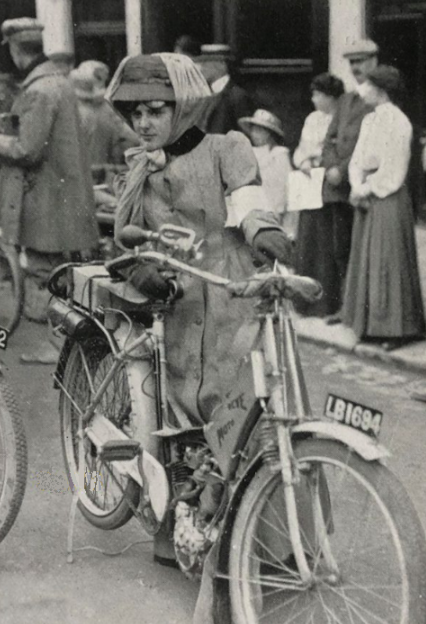
“VARIABLE GEARS of all kinds are slowly but surely increasing in popularity, and as soon as there is a gear which can be fitted to all and sundry existing machines without structural alterations or materially increasing weight and price, then they will be universal, and no motor cycle will be considered complete without one.”
MOTOR CYCLE enthusiasts were spoilt for choice, witness this list of marques available in British dealers (where proprietary engines were fitted they are shown in brackets): AC, Advance, Alldays, Anglian (JAP and De Dion), Ariel, Arno, ASL (Fafnir), Bat (JAP), Bradbury, Brough, Brown, Calthorpe (W&P), Chater-Lea (Chater-Lea and JAP), Clyde (JAP and W&P), Clyno (Stevens), Corah (Corah and JAP), Dene, Dot, Douglas, Eland (JAP), Enfield, FN, Herdtle, Hobart-Bird, Humber, Indian, James, Kerry (Abingdon), Lincoln-Elk, LMC, Matchless (JAP and W&P), Midget Bicar (Fafnir), Minerva, Motosacoche (Dufaux), Moto Reve, Moto Velo (Singer) New Comet (Sarolea), NLG (JAP and Peugeot), Norton (Norton and JAP), NSU, Oakleigh (Peugeot), Omega, P&M, PMC, Premier, Quadrant, Rex, Roc, Scott, TAC, Torpedo (Fafnir), Triumph, VS (Peugeot and FN), Waverley (JAP), Wanderer, Wilton (Dufaux and JAP), Wolf (Stevens), Zenith.

AN UN-NAMED genius patented a bike propelled by a turbine driven by compressed air, “the initial pressure having been obtained by means of a tyre inflator or other pump”. As well as driving the bike the turbine powered a pair of pumps designed to inject air into the tank. And when the bike was free-wheeling an auxiliary pump geared to the rear wheel forced more air into the tank. Hey presto: perpetual motion!
MAUDES MOTOR Mart prices for some popular models make interesting reading when inflation is allowed for. A TT Model Triumph was £43.15s (£4,860) plus £6 6s (£700) for a free-wheel clutch; 5hp Norton twin, 43 guineas (£5,100); Model C flat-twin Douglas, 36 guineas (£4,200); 3½hp two-speed Humber, £50 (£5,700) and four-pot Wilkinson TAC De Luxe, £73.10 (£8,300).
FC BAGSHAW, a competitor in the 1909 TT, gave a talk to the Harrogate &DMCC in which he advised all motor cyclists who had the time to spare to enter for the event. He considered the 1909 race had proved the superiority of singles, suggesting that “TT machines should not be too lightly built (for preference the weight should be slightly in
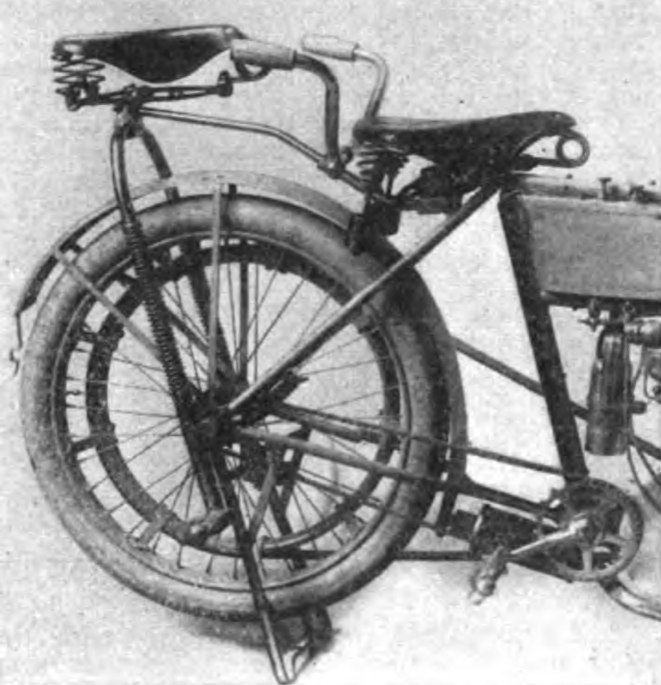
excess of the rider’s), that machines should have a short wheelbase, low saddle position, and wide handle-bars, a large petrol tank with big filler cap, automatic lubrication, together with ordinary hand pump, and special care should be taken that the mudguards are firmly fixed”. As for protective riding gear, “Mr. Bagshaw pinned his faith to good warm woollen vests and pants next to the skin, also a woollen shirt, thick socks, strong riding breeches with leggings, a leather waistcoat with sleeves, ordinary cloth coat, and warm thin gloves, a good body belt, strong boots, and a pair of mica goggles”. As to fitness: “Personal training should commence at least three months previous to the race, but before commencing a strict medical examination should be first taken. Then should follow a cold plunge first thing in the morning—not, however, to be taken straight out of bed, but rather allow the body to cool a little. Dumb-bell exercise should follow for no more than a quarter of an hour, taking particular care that the breathing is attended to. After breakfast have a short spin, and then attend to the ordinary work of the day. At night another spin, a light meal, exercise for another quarter of an hour, then early to bed. Very little or no tobacco or intoxicants should be touched; plenty of cold water is recommended, and a hot bath once a week.” He read out a letter from TT winner Harry Collier: “I am of opinion that the race causes more mental strain than physical strain, and that the strain on the rider is greatly exaggerated, and that a course of’ dumb-bell exercises to tone up the muscles of the arm and wrist and plenty of fast riding, coupled with the rider’s ability to tune up his machine, is really all that is necessary.”
“WITH THE increasing number of multi-cylinder machines in use and the introduction of two-stroke engines, either in twin or single-cylinder form, motor cyclists should endeavour to acquaint the police and others in authority that the sound caused by the exhaust of a high-speed multi-cylinder motor cycle engine, possibly running on the low gear, does not mean that it is travelling at a speed in excess of the legal limit.”
MORE THAN 350 clubmen rode into Richmond, Yorks for the annual meeting of northern clubs. What had started out as a social gathering of northen MCCs evolved into the Northern League, which attracted 21 clubs. The league organised a hillclimb at Staxton,

followed by a ‘smoking concert’ in Scarborough presided over by the Leeds MCC secretary. The Sheffield and Hallamshire MCC secretary gave a talk on ‘Some Points in the Theory of Belt Transmission’; there was a lantern-dlide show of ‘aviation meetings’ at Doncaster and Blackpool with a few slides of the previous year’s Staxton hillclimb–you can almost hear the riders’ running commentary. Following a prosal by Harrogate, seconded by York, the league elected its first secretary and to meet at York “at an early date, to consider the position of the Northern League in relation to the Auto Cycle

Union”. They also laid plans for a ‘flying kilometre’ contest. The Yorkshire Evening Press reported: “One of the amusing features of the afternoon’s contest was the appearance of an ACU official, who warned each competitor of the dire results of his participation in the competition [as it was not authorised by the ACU they could be banned from all ACU competitions]. It is said this same official himself defied last year the body which he yesterday represented…The impression among the motor cyclists at Staxton was that if the Auto Cycle Union would ask for a reasonable inclusive sum to hold an inter-club hill-climb, they would be quite ready to recognise the Union as the authority of the sport.”
FELIX SCRIVEN of the Bradford MCC wrote to ACU secretary Fred Straight: “Referring to our conversation which took place at Sutton Bank, I herewith beg to make the following suggestion, which I trust you will put before your committee. Having been present at the conference of the Northern League of Motor Cycle Clubs at Richmond, I am of the opinion that some agreement should be come to between the League aforementioned and the ACU. I would suggest that a conference be convened at which one or more representatives of the ACU should meet the secretaries of the Northern clubs concerned to consider the advisability of the clubs forming the League being affiliated to the ACU for a lump sum, instead of so much per head, on the same lines as the North-Eastern Automobile Association has been admitted. I trust that your committee will see their way favourably to consider the above.” Inevitably, the chaps got together to sort things out. “A few members of the ACU Committee and a few of the Northern League met at York on Friday evening last, and had a most agreeable talk on the points affecting the relation between some of the Yorkshire clubs and the Union. It may be safely pre dicted that the outcome of the meeting at ‘a wayside inn’ will be for the benefit of the pastime.”

WITH MORE riders flocking to the Auto Cycle League banner Captain C Battine (late 7th Dragoon Guards and 15th Hussars) gave a lecture at RAC HQ on ‘The Role of the Motor Cycle in Campaigning’.
“A MOTOR CYCLIST who was recently summoned for exceeding the speed limit put forward the novel defence that the inch-long ash of his cigar was unbroken at the moment at which he was stopped. This circumstantial evidence secured his acquittal.”
TWO NEW MACHINES debuted in the ACU trials. The Reg Samson designed by (you guessed it) Reg Samson of Birmingham who also produced a range of accessories. Power came courtesy of a 3½hp 500cc Premier engine which could be removed complete with its carb, mag etc by taking out three bolts. The sloping top frame tube gave a low riding position; other features included brazed rather than bolted frame lugs, a ‘clean’ handlebar and a large fuel filler fitted with a fuel filter. The other debutante was the Omega, which hailed from Wolverhampton. It was very much a powered bicycle available with a conventional or open lady’s frame; the pedal crank ran through the horizontal engine’s hollow crankshaft. Other features included a clutch inside the crankcase and fully enclosed chain.

“A PECULIAR accident took place at the level crossing over the Great Northern and Great Eastern Railways at Beckingham the other evening. A clergyman who had ridden his motor cycle from Oldham took the red danger lamp on the closed gates for the tail light of a traction engine, and in turning aside to pass the vehicle, as he thought, he crashed into the closed gates. His machine was wrecked, but he escaped with a severe shaking.”
IXION REMARKED: “Most of us can remember when every young cyclist aped the genuine speed men by specifying a pair of ram’s horn bars, a short steering head, open-sided sprint tyres and an apology for a saddle. He might not be a speed merchant, but he had to look like one, or pass for an old fogey. Much the same is happening in certain sections of motor cyclists. Long, low, light machines, with very little silencer and lots of hooter are the thing; if you carry a toolbag more than an inch thick you are wnritten down as a potterer and no sportsman, because certain racing jockeys and their track equipment are the models upon which the hero-worshippers of the day mould themselves.”
“FANCY THE ACU having to limit the [TT] entries—and 90 machines being the limit—when we can remember what a job the ACC had a few years ago to rake up three motor cyclists with racing machines to fight for old England in the International Cup. Now the cream of the dare-devil amateurs are mustering and tuning for the Isle of Man, and, as for good professional riders, one or two firms would give A great deal to find one unemployed; there is a great dearth of ten stone men with iron nerves, steel wrists, and tlie gifts of an expert mechanic.”

OF 98 SOLOS and 15 combos entered for the MCC’s London-Edinburgh trial 88 solos and all the outfits started. “It was a glorious evening; the unsettled weather seemed to liave melted a-way, it was not unduly cold, and the night was clear with a slender moon shining in the north-west. As the time for starting drew near, the crowd thickened, and the glow of acetylene lamps lit up the whole locality. Most men used two up-to-date headlights, some one headlight and an electric lamp in reserve…On the stroke of nine,

Dickson (the captain), on a 5hp Indian, was the first to be sent off. It was an impressive scene—the glare of the lamps, the throng of people on the balconies and at the windows of the surrounding houses, the good-tempered and business-like police, their helmets showing up in the glow of the headlights…One after another at half-minute intervals the men got away, each machine starting with the utmost promptitude—a splendid advertisement of the high pitch of excellence to which the motor cycle has attained. Gwynne went off with three lamps burning brightly. Captain Harkness, on one of the new Enfields, depended on an electric lamp. Many of the men used Crole Rees’s and Bell’s route card holders…The ever-smart appearance of H Roberts’s P&M aroused much admiration, and the start of Captain Sir Robert Arbuthnot evoked an enthu siastic cheer…It was a glorious night; the dry roads seemed to stream ahead in the liglit of the lamps; every doubtful corner had a man waving the direction with a lamp, and losing one’s way was practically impossible…All along the route, in the ‘wee sma’ hours’ enthusiastic motor cyclists turned up at various places to see the riders pass…Grantham, where an excellent and smartly-served breakfast was ready. It was all splendidly arranged; the men checked in at one entrance of the George Hotel yard, had breakfast, and checked out at the other entrance. In the yard Chater-Lea,
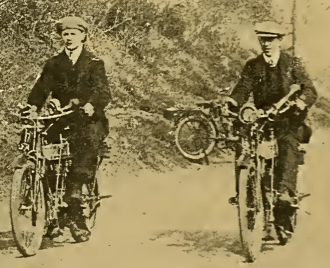
with his 7-9hp Chater-Lea and sidecar fitted with the new Chater-Lea twin mov engine, reported lamp and carburetter troubles; JC Collins (5hp Roc) was trying hard to start his engine without success; P Stevens (3hp Wolf) reported inlet valve trouble in the first ten miles, but said his machine was going well afterwards…On Carter Fell J. Godsall towed a lightweight rider up to the top, and as the latter kept his engine firing they climbed at a splendid speed. On the summit an S.A.C. sign marks that Scotland is reached…Straight ahead the Firth of Forth and the Fifeshire Hills could be seen, and even the Bass rock could be dimly made out. Numerous Edinburgh MCC members met the men at this section of the route. From that point right up to Liberton, the last check, the road was vile, and a terrible ordeal to face at the end of so long a journey. Thus terminated one of the most successful Edinburgh runs ever held…Reliability—Thy Name is Motor Cycle…SC Ferryman (3½hp Ariel) broke his exhaust lifter shortly after starting and had to use his compression tap instead. Stanley Webb (3½hp Triumph) suffered delay through punctures near Darlington, and was so late at the cup check that he resolved to relinquish the idea of competing for that much-coveted trophy. Karslake was troubled with

overheating on Carter Fell. Near Jedburgh Williamson, who was driving a smart Rex sidette, the sidecar wheel of which steers in conjunction with the bicycle front wheel, was ditched by two cars but fortunately without suffering serious damage…Four sidecars out of 15 failed to get through, and out of 103 motor cyclists who started only 16 failed to finish. Subject to confirmation by the committee, 75 motor bicycle riders will receive gold medals, and one will receive a silver medal. Of the sidecar riders, eight will receive gold medals, one a silver and the other a bronze.” George Brough won the MCC’s London-Edinburgh trial aboard one of the 500cc. singles made by his dad. He would win again in 1911/12 to win the Motor Cycling Cup.
TOP OF THE bill at the Empire Theatre, Sheffield was American daredevil Arthur Burr ‘Wizard’ Stone and ‘The Globe of Life–a 16ft steel mesh sphere. Wizard proudly described his mount: “It’s a single-cylinder Indian and I have had it in use for six years. You can bet I know something about motors. Why. I had the first in America – a 2¼hp De Dion-Bouton, used in a tandem frame for pacing. Then I rigged another up, and beat Albert Champion and Henry Fournier, at that time the best men in Europe.” An onlooker described his act: “The motor cycle is put in the globe and before one has time to weigh up the situation Stone, by the aid of a few pushes on the pedals, is careering dangerously at a speed of 30 or 40mph round the halfway mark. Then begins the ascent of the upper half, the speed increasing until he shoots into the very top of the sphere, becoming a whirling flash of confused shape. His head hangs down into the centre of the globe at an almost stationary point, from which legs, body and arms radiate in a circle so small that they seem to cover the entire circumference. Then Stone dashes against the lower side, and rushes up the opposite incline… he makes the mad dash down, up and over again six times in less than six seconds.” Wizard sometimes took his wife as pillion in the globe. He had an eventful flying career too, claiming to have been the third person to fly after Wilbur and Orville Wright before becoming a test pilot (though come to think of it every pilot was a test pilot in 1903), spent some time barnstorming in Australia and New Zealand with his Bleriot monoplane and, in 1911, fell 1,000ft into Lake Michigan.


MOTOR CYCLISTS in St Petersburg got together to set up the confusingly named French MCC. Their first run, to Tzarskoi-Selo, included four Wanderers, two FNs, an Adler, a Motosacoche, a Peugeot, an Allright, a Mars and a Triumph. The bikes reflected the international nature of the club, which was formed by students who had come from Western Europe to study in Czarist Russia.

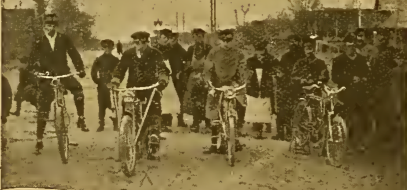
IN ITALY THE Unione Sportiva Florentina hosted a gruelling hillclimb of 10 miles 440 yards at Pontassieve-Consuma. Bartolini (1½hp Motosacoche) won the 250cc class in 20min 13.4sec; Squilla (2hp Buchet) won the one-third litre class in 21min 35sec; Borgo (3½hp Borgo) won the 500cc class in 16min 3sec.
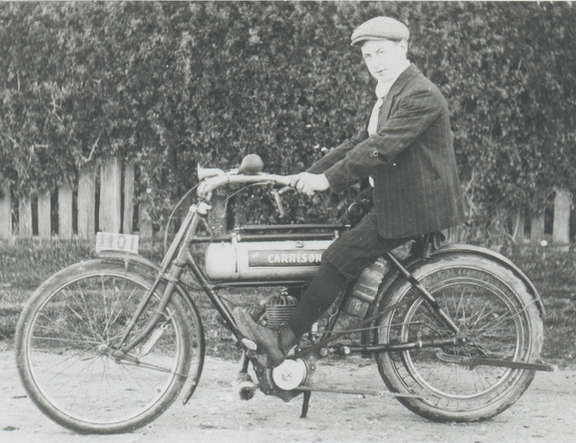
“MR EL OVINGTON (formerly president of the FAM, and at present a member of the FAM Competitions Committee), who is now in this country, claims for Fred Huyck (one of the most successful American riders) the fastest speed ever accomplished on a motor bicycle. When he made his marvellous record of a full mile in 42⅖sec, ie, 84½mph, on a 7hp Indian on a three-lap track, Huyck covered the second lap in I3⅕sec, equal to a speed of 90.91mph. These figures have been specially pointed out to us to prove that it is not necessary to have a “freak monster” in order to capture world’s records for a motor bicycle. The same remarks apply to racing motor cars; the vehicle with the biggest engine is not necessarily the fastest.” Jake DeRosier, also on a 7hp Indian, lapped the Los Angeles circular wooden track, covering 50 miles in 39min 13sec and 100 miles in 86min 14sec.
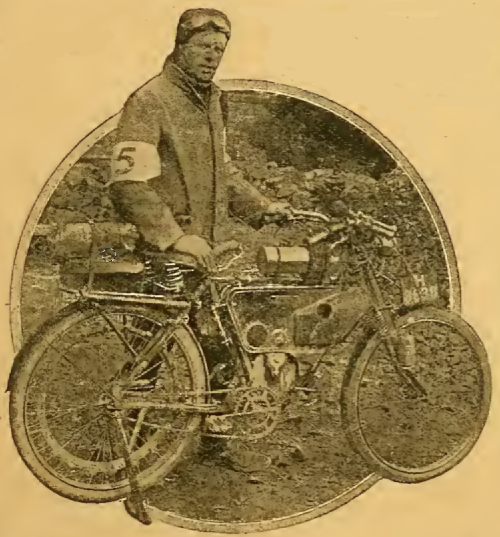
HERO OF THE Scottish Six Days Trial was Motosacoche trade rider JS Holroyd. But the original caption doesn’t tell the whole story; Holroyd had ridden his diminutive 1¼hp Motosacoche with distinction through the ACU Quarterly Trials, two MCC London-Edinburgh-London Trials and the ACU End-to-End Six Day Trial (he won a gold). Holroyd was the only one of the four gold-medallists to ride a single-geared bike, let alone one with so little power. He later commented: ” Any other trial ever held was a mere picnic compared with the Scottish. Quite apart from the frightful hills we have had to get up, the amount of severe gradient thrown in in the ordinary way has been appalling, and when you are up the hills the surface has been so bad and the corners so sharp and so numerous that it has been the hardest thing in the world to catch up schedule time again. I got up most of the ordinary hills in good style, mostly without pedalling, but you could not expect 1¼hp to climb places where two-speeded 5hp machines, ridden by men lighter than myself, were sticking every day. As you saw, I make a rule to get up as far as I comfortably can in the saddle. Then, when I am tired of pedalling, I get off and slack back my jockey pulley a trifle, so that the belt slips a little. Then I walk alongside at three or four miles an hour, and the machine helps me a little. Even thus I got up a good deal faster than some of the others.”
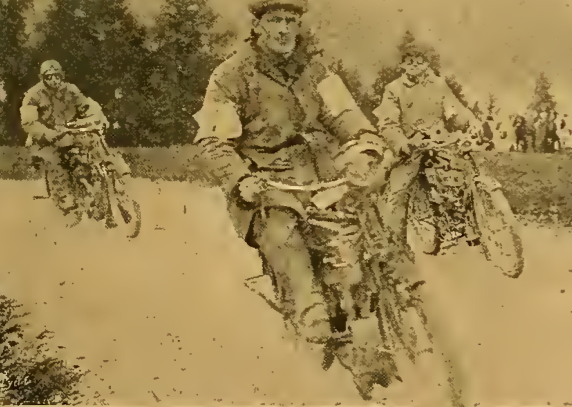
“A SPLENDID ENTRY WAS received for the Bradford Motor Cycle Club’s second annual open hill-climb at Cockshoot Lane, about three miles from Skipton…Cockshoot Lane is by no means an ideal hill. Its severity is undoubted, but it is of too tortuous a nature, and, moreover, too narrow to encourage riders of fast motor cycles to climb it at speed, and no one was surprised that several suffered bad spills.. The chief award in the competition was a handsome silver challenge cup for fastest time, presented by Eric S Myers, a popular member of the club. The practising was marred by an unfortunate accident, which might have proved much more serious than it did. Mr Myers, excellent sportsman that he is, had spent some time tuning up one of his motor bicycles with the idea of lifting his own trophy, and incidentally settling a few good-natured differences with one or two of his trade rivals. But he was doomed to disappointment, for on his very first flight up the hill (everyone who saw him said he was ‘really flying’) the rear tyre burst, pitching Mr Myers over the handle-bars, and he was lucky to get off with a few bruises and a bad shaking…The Bradford club, it may be recalled, was the first organisation to seriously take up the question of standard machines in competition. A committee of scrutineers examined each machine at the weighing scales to ascertain whether it conformed to the regulations…Marshall (Triumph) was first up [in the Standard Pattern Single-Cylinder class] and he created quite a stir, for hitherto the spectators—who, by the way, had persisted in meandering aimlessly about the road—had only seen low-powered machines…A couple of two-stroke Scotts [in the Standard Touring Twins class] ascended the hill without apparent effort in their usual silky manner…Lord (Rex) caused alarm, but later considerable amusement at the stopping and starting test. He came up to the flag well, judged the stop to a nicety, and, on receiving the word to start, stamped on the low-gear pedal, which caused the front of his machine to rear straight up for all the world like a bucking broncho. Lord exhibited no fears whatever, he coolly kept his place in the saddle and got away in splendid style…[In the Single-cylinder Racers class] Marshall again led the vanguard, and his TT Triumph, though geared 3¾ to 1, showed no perceptible slacking of pace except when the rider was obliged to switch off for the corners. Silencers were optional on racing machines, and Cockcroft, dispensing with his, created a rare din. Hugh Gibson, on his End-to-End sidecar record machine, stripped of all superfluous, parts, did well [see End-to-End feature, 1911]. Some powerful monsters competed in the open class {for any motor bicycle with engine not exceeding 1,000cc] and the spectators wisely allowed extra space at the corners. Moorhouse, the first rider up, again judged the corners nicely, and a moment or two later, another Indian rider, HD Shaw, drove the spectators’ hearts into their mouths. He was admittedly miles the fastest of the bunch, and though he switched off and jammed on his brake some yards before the top bend, he could not clear the ditch, and rider and machine parted company, the former rolling over and over, but, to the astonishment of the onlookers, he immediately sprang up and walked to his machine which reposed in the ditch…J Scriven (7hp Rex) wins the Eric S Myers Trophy for fastest time.”
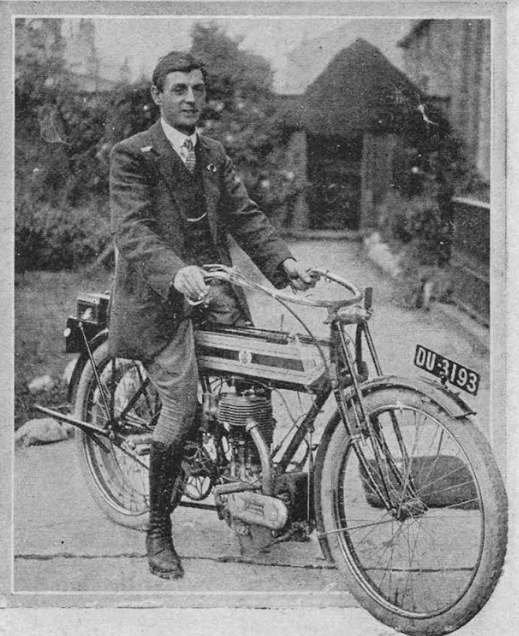
THE ANNUAL reliability trial organised by the MCC for The Motor Cycle Fifty-guinea Challenge Cup, over a 100-mile course centred on Daventry, attracted a record entry of 18 teams, each comprising five solos and a combo. The Great Yarmouth boys carried imitation bloaters as mascots, the Brummies wore sun bonnets and the Derby &DMCC team “came to the post with large placards on their backs, which were not approved by the officials and were removed”. They were reminded that “the competition, although a sporting event, should be treated seriously, and placards of the kind referred to will be discouraged in the future”. Which seems a tad sniffy. For the fourth time in sixth years the Coventry MCC won the cup, with a perfect score. The Northants team also scored 100%; the award was made on time errors. The Bristol team was just behind in third place, ahead of Sutton Coldfield, the MCC, Birmingham, Oxford, Sheffield & Hallamshire, Islington, North-West London, Essex, Nottingham, Great Yarmouth, Norwich, Derby, Manchester and, bringing up the rear, Herts County. The Herts team weren’t helped by the penalty imposed on their combo pilot, Billy Pratt. When he copped a sidecar wheel puncture his passenger scrambled onto the carrier and rode there for 55 miles before an MCC observer told him passengers had to remain in their sidecars and disqualified him. Fierce.

“THE LIVERPOOL Stipendiary magistrate worked himself up into a state of wrath on hearing the case of SL Leftly, a motor cyclist summoned for having ridden his machine at a dangerous speed without sounding an alarm. Defendant estimated his speed at 6-8mph, whilst the constable inflated it to 18 or 20. Mr Shepherd Little, the magistrate, is reported to have said: ‘I take a great interest in these wild animals, and when I see them I am amazed at the speed that they strike me as going at. I think these animals must be kept in check. The defendant will be fined 20s and costs.’ If he made use of such expressions he evidently forgot his manners, and we would remind him that a stipendiary’s duty is to admmister justice, and not to gratuitously abuse a defendant brought before him on such a doubtful charge.”

THE TOURIST TROPHY race at Brooklands was run over 66 laps to match the mileage of the TT proper. There were 21 singles and 17 multis on the start line; each rider was allowed one spannerman at the ‘replenishment and repair depot’. As with the TT the bikes had to be equipped as tourers but unlike the TT there were separate prizes for multis and singles. S Witham (Bat twin) covered the first 50 miles in 45min 45.8sec, knocking almost three minutes off Colver’s record when, while doing almost 70mph on the Byfleet banking, his front mudguard came adrift, locking his front wheel. Witham

reckoned he completed 12 somersaults but walked away without a scratch. By the times the leading rider, JT Bashall (BAT) had completed 40 laps only 18 bikes were still in the runningm Moorhouse (Indian) was laying second with 37 laps completed; Marshall (Triumph) was leading the singles. Mechanical failures continued to mount; 12 laps later a broken valve caused his rear cylinder head to blow off, leaving Moorhouse and Franklin, both riding Indians, in first and second places. At this point Gwynne, who had previously come off, scraping a lot of skin off his face, suffered a front-wheel blowout but “with great clever- ness and pluck managed to save himself amid the cheers of the spectators”. Moorhouse held onto his lead to the end with his team-mate CB Franklin third, putting a smile back on the Indian camp’s collective face following the TT debacle; Bowen was second on his Bat-JAP. F McNab (Trump-JAP) led the singles, followed by J Marshall (Triumph), AR Abbott (Rex) and FL Goodacre (Triumph).

SEVEN MOTOR CYCLE clubs in and around New York formed the Metropolitan Association of Clubs. Motorcycle Illustrated commented: “The organization will be the most powerful and undoubtedly the most influential in motorcycle circles in the United States.” A committee was elected which planned the associations first event: a inter-clb dinner. “Arrangements will be made on an elaborate scale, and there is a big time on prospect for all who attend.”
THE KING TIRE Co of Milwaukee launched a leather motorcycle tyre “warranted to withstand all road damage such as blowouts, rim-cuts and punctures”.

THREE INTERESTING newcomers on the US market included two with shaft drive. The SDM, built by SD Manufacturing of Brooklyn, came with 440cc and 500cc single-cylinder engines and a fully enclosed shaft drive incorporating a friction-type shock absorber. The Marathon, from machine-tool specialist LE Rhodea of Connecticut, was also a shafty; it incorporated a multi-plate clutch and two-speed transmission. Power in this case came from a 448cc 7hp vertical-twin two-stroke. The Crown, from the Great Western Co of Indiana, was unashamedly based on the 3½hp Triumph; it used “an English free engine”, Brown & Barlow carb and “special English strainer” on the petrol pipe.

MORRISON-RICKER of Ihio were not shy about the virtues of their ‘Rist-Fit’ gloves: “Wile dressy and soft as kid they wear like iron due to the leather which is dressed in our own tannery combining softness and flexibility with toughness. When soiled they are washable in soap and water or gasoline.”
THE HENDEE company was running a night shift to boost annual production to 7,500 Indians, making it the world’s leading motor cycle manufacturer. It enlarged its factory by 150%, giving it a capacity of 20,000 bikes a year. It was also expanding into aircraft engines with a 25hp in-line four and a 50hp V8. However the company was deprived of the services of Jake De Rosier at the beginning of the year: he was suspended by the FAM for three months for reckless riding and “talking back to the referee”.

EISMANN OF Stuttgart, which was a pioneer magneto manufacturer (supplying a low-tension/coil model to Roc and NSU from 1903) came up with an automatic advance/retard for its conventional high-tension mag. “Two governor balls are mounted on links connected to a block which slides in a double spiral groove cut on an extension of the armature-shaft. As the speed of the machine increases the balls fly outwards, rotating the armature further in the direction of rotation, with the result that the maximum position remains constant, irrespective of the amount of advance and retard, and the quality of the spark does not deteriorate. A range of advance and retard of 45° is obtained.”

THE ACU TWEAKED the route of its six-day End-to-End trial to make it a little tougher; the mileage was extended to 1,019 miles. These excerpts from the contemporary report give a taste of the action: “Numbers 27 and 28 have a curious contrast, 27 being Cox’s diminutive Singer Moto-Velo [newly launched with a 1¼hp 226cc Dufaux engine—Ed], and 28 Fox’s mighty 8hp Bat…Many of the competitors carried bunches of seaweed, gathered from the rocks at Land’s End, as mascots, while sundry and various devices for holding route cards were to be seen on the majority of the machines. The two-speeders, the clutch-fitted Triumphs, and pre-eminently the Scott,
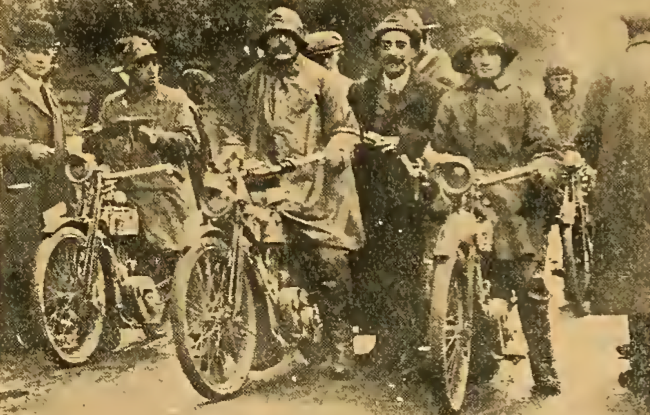
created a most favourable impression by the way in which they started. Many more speedometers than have been noticeable before in ACU competitions were fitted to the machines. All the machines started with wonderful ease with one exception—Abbott’s sidecar, which was a trifle dilatory in getting away…the ‘path-finder’ or road indicator had again neglected his task, and many a tired man went astray after Kenmore. [other competitors were sent astray when some joker interfered with a signpost]. Rough roads, steep hills, unrolled metal, and ruts tested men and machines to their utmost in the later

stage through Fearnan and Tummel Bridge. Arter ran out of petrol at Tummel Bridge. Eastwood and Williams suffered punctures. Houghton took a corner too fast, came off, fell into a ditch, and dropped his machine twenty feet down a bank, was rescued, and finished. Bainbridge (Rex) retired ten miles from Amulree with a broken fork, and Savoy (Premier) near Tummel Bridge through a broken connecting rod…The once bad road to John-o’-Groat’s has now been vastly improved…One short stretch then the hill was surmounted, and before us lay the blue sea studded with islands, and far below on its shore stood John-o’-Groat’s House, the goal which we had all travelled 1,019 miles to reach.” There were 71 starters of whom 53 survived the trial; 21 of these lost no points. Five of the 21 were on Triumphs, three on P&M, three on Bradburys, two on Douglases, two on Indians and one apiece on Enfield, Premier, Excelsior and Scott. There was an odd PS to the trial. TH Tessier retired near Kendal when Bat-JAP started knocking which was found to be down to a worn out big-end bearing. When the engine was stripped silver sand was found in the crankcase. JA Prestwich and Co offered a £20 reward for information leading to the culprit’s conviction. That would be worth more than £2,000 today; JAP was clearly cross.
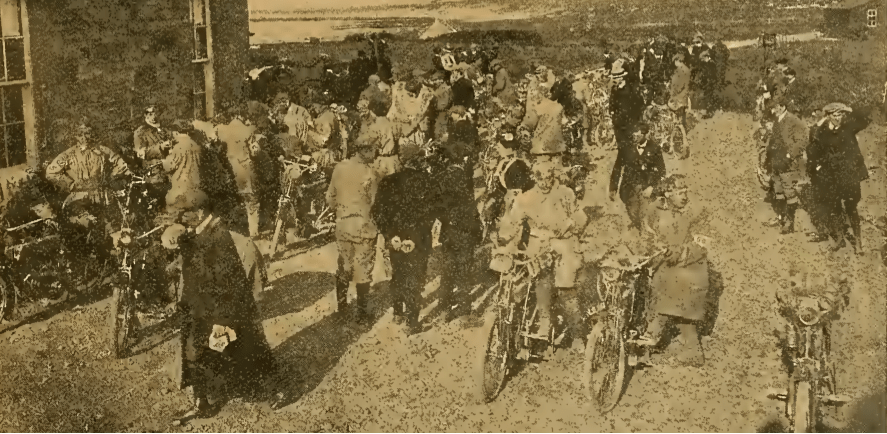
THE SERVICE Co of High Holborn, London WC, brought out what might well have been the first ever shaped bike cover. The manufacturers claimed: “It should be useful to military motor cyclists in manoeuvres when they have to leave their machines in the open for any length of time.”
“THE ACU QUARTERLY Trials held on Saturday last will be handed down to posterity because two lady competitors figured on the list and because no less than 22 of the 70 entries were lightweights. Among the entrants several interesting machines were to he observed. The new Chase, 2½hp 270cc Sarolea engine, was a newcomer. The new AJS, made by AJ Stevens of Wolverhampton, uses the well-known 2½hp 290cc Stevens engine and is fitted with a large Bosch magneto, rendering starting particularly easy; mechanically-operated valves, both worked otf the cam; Druid forks; handle-bar control; and large saddle. The rear mudguard is attached to the carrier and has no indipendent stays, and several other refinements are fitted. The two new lightweight Humbers aroused a good share of admiration. This neat little machine is a powerful motor bicycle in miniature. The dainty engine is of 1½p 197cc, and is fired by a lightweight Bosch magneto situated behind the cylinder. Druid spring forks are fitted, and a B&B handle-bar controlled carburetter. Another newcomer was the Romp, fitted with a JAP engine and a free-engine clutch.”
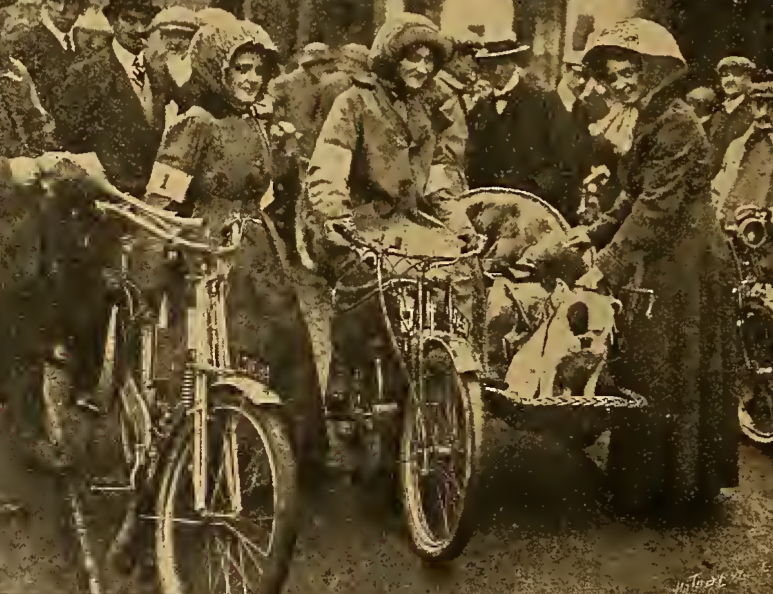
POSSIBLE ENCOURAGED by the success of the Indian tribe in Britain, MM (Marsh-Metz) set up a London agency offering its well proven 4hp single (fitted with British saddle, tyres and belt) with the promise of a 7hp twin.
IXION WROTE: “There are a sprinkling of riders who always ride TT machines with dropped handle-bars and without silencers or hooters, and normally prefer a Brooklands skull-cap with ear guards to a respectable cap. These riders mean no harm, and probably do no harm yet, as they are mostly experts or on the road to become experts, but they are rather inclined to show off. I met one negotiating a gentle curve on the tramlines in Worcester the other week in truly portentious style. His engine was barking like a gatling-gun, his back was horizontally flattened along the tank top, his wrists a few inches off the front wheel axle, his nose where the lamp-bracket ought to have been, and he was ‘leaning out’ in the most amazing style, with his machine tilted over the other way at a surprising angle, to take a gentle bend of about l00 yard radius at a speed of perhaps 15mph. But the innocent constable evidently mistook him for a racing man on the ‘scorch’, and such practices will perpetuate police activity, and cause quiet gentlefolk to avoid motor cycles like poison.” Thank goodness we don’t have riders of that ilk on 21st century roads.

TWO DECISIONS from the ACU: “The ACU has now decided officially to recognise a flying start for the hour record. Previously a standing start only was permitted. Consequently the British and American records will be comparable in future.” And…”As regards the Northern League Hill-cUmb the Auto Cycle Union desires it to be known that this event is unauthorised, and is proclaimed, and consequently all competitors and officials concerned are disqualified from taking part in any ACU competition.”
THE FIRST appearance of what is now a standard workshop tool: “The Motor Stethoscope. This is the name of a novel instrument sold by Brown Bros, Oxford Street, W, for locating strange sounds in an engine. By its means every click, knock, or tap can instantly be traced to its source. When the test rod is placed against the valve guide, every scrape in the action of the valve is distinctly heard, and when placed over the part v/here any knocking occurs, the pounding will be heard like blows of a hammer.”
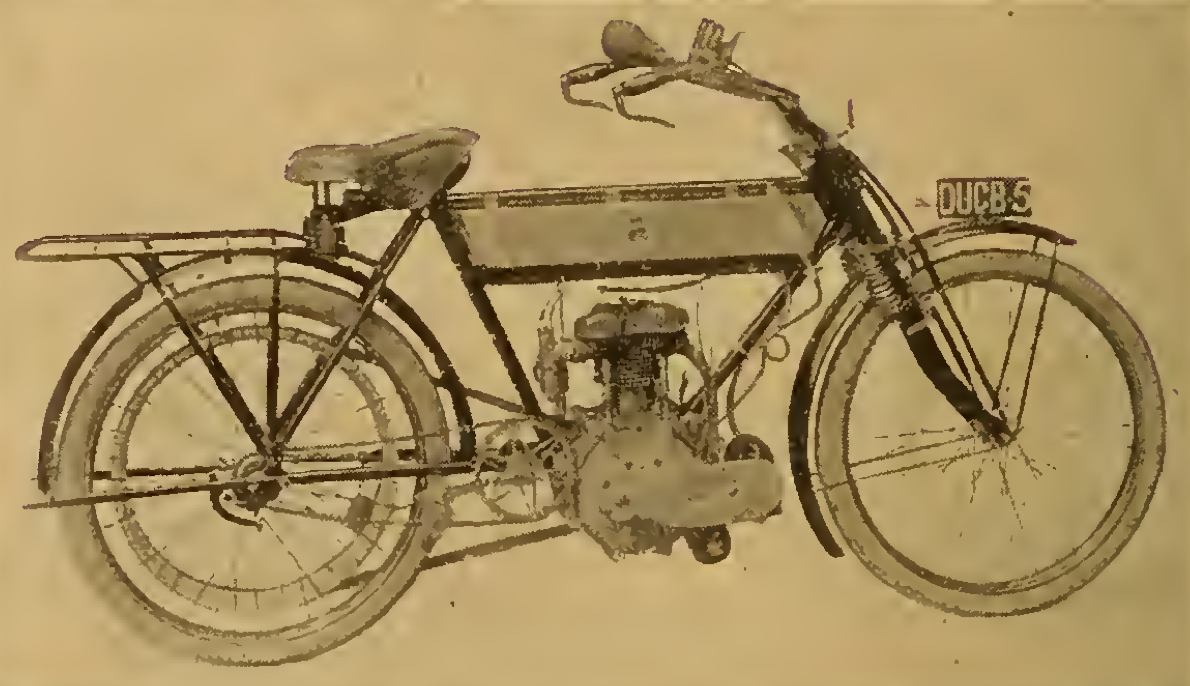
CALCOTT BROS progressed from supplying frames and components to making complete motor cycles powered by 3½hp 430cc White and Poppe engines. According to the Blue ‘Un, “The machine presents no special features, but is a simple, well designed, and sensibly equipped touring mount…Practically all the large bicycle manufacturers have produced a motor bicycle or intend to have one ready by the date of the motor cycle shows. Next year should exceed all previous records in motor cycle construction.”
A 505-MILE ‘endurance run’ staged by the Federation of American Motor Cyclists attracted 127 competitors. The run, which started and finished at Philadelphia, was hit by heavy rain and riders had to plough through a 15-mile section covered in clayey mud up to 10 inches deep which stopped three-quarters of the field. Only three riders gained full marks, all mounted on Thors.
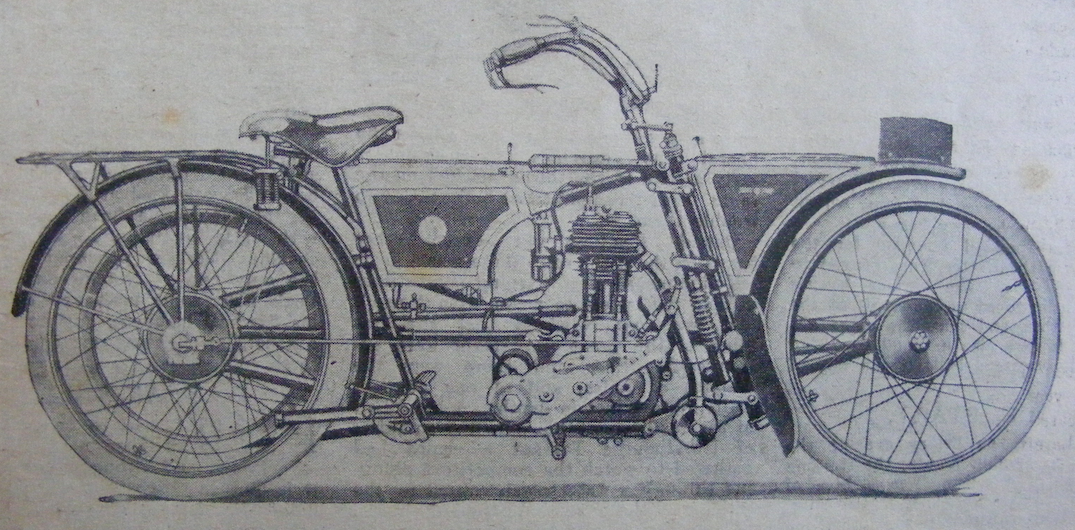
AS SPRUNG FORKS became ubiquitous they were made in all shapes and sizes–though many racers opted for a rigid front end.

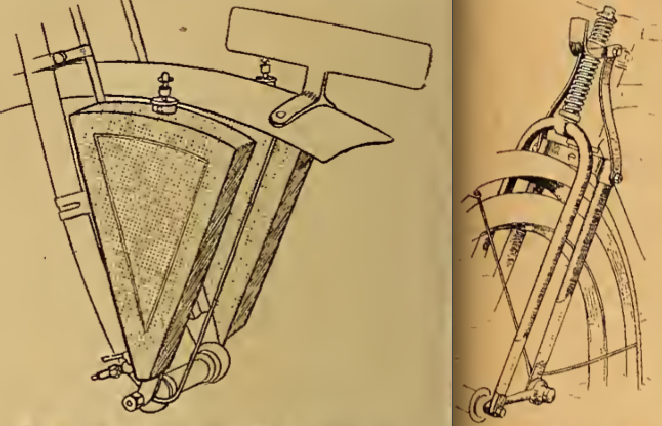

THERE WAS A short-lived fad for ‘naming’ motor cycles and painting said name in large letters on the petrol tank. One correspondent to The Motor Cycle was clearly not impressed: “I would like to suggest that in the interests of those motor cyclists who object to seeing the sport rendered ridiculous you open a fund for the establishment of a special track on which these mentally affected gentry who desire to have their cycles named could disport themselves. A kiosk should be provided and a licence issued to some enterprising toy vendor to sell Teddy Bears, climbing monkeys and other mascots, also children’s alphabetical blocks for forming the desired names.”
“IT SEEMS TO be the general impression that driving a motor bicycle and sidecar from the passenger’s seat is both difficult and risky. The other day we made our initial trial in this direction. On the way to pick up a passenger with a Zenith Gradua and Mills-Fulford rigid pattern sidecar, the wheel of the latter lifted rather alarmingly in rounding a corner, owing to the absence of a weight in the seat. The driver there and then decided to try controlling the machine sitting in the sidecar, and the result of the experiment was entirely satisfactory. Since that experience we have continued to drive whilst reclining in the sidecar, and are convinced that this method is far safer than driving a rigid pattern sidecar without a passenger.”
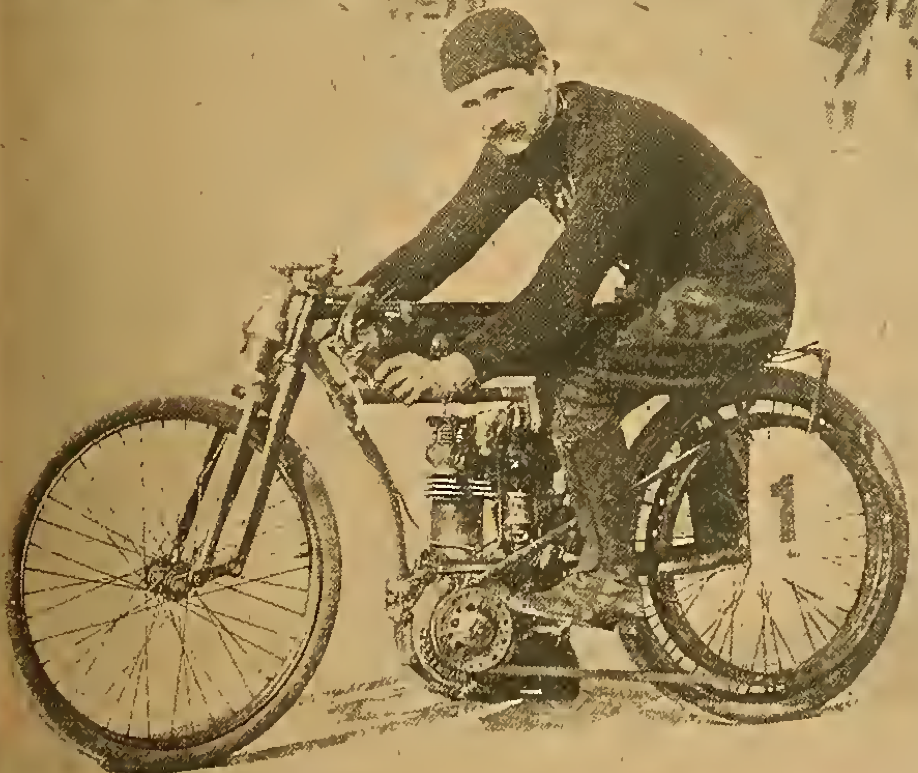
THE ACU HAD not staged an annual race meeting since 1902, when it was still the ACC. In 1910 the action moved to Brooklands where Harry Martin won the first race (up to 76×76/345cc) on his 2¾hp/344cc Martin-JAP. Charlie Collier was runner up (2¾hp/340cc Matchless) with FE Barker (2¾hp/340cc Dart) third. The open handicap (up to 1,000cc) was won by AC Maitland (3½hp/482cc Trump-JAP), ahead of CE Bennett (5hp/634cc
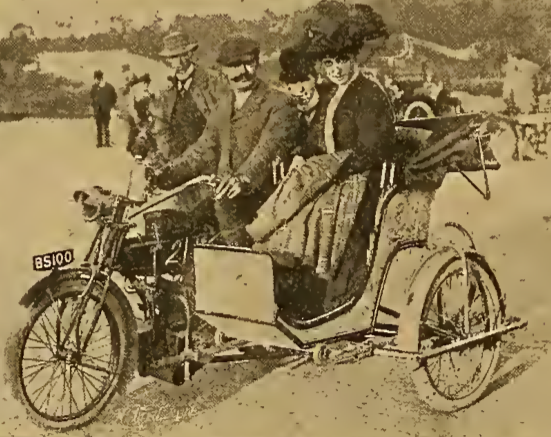
Indian twin) and Guy Lee Evans (7hp/994cc Indian twin). First place in the Passenger Handicap (up to 1,000cc) went to Harry Collier 6hp/770cc Matchless-JAP twin and sidecar); second, E Frasetti (7hp/952cc VS twin and sidecar); third, Charlie Collier (6hp/770cc Matchless-JAP twin and sidecar). Then there was a novelty event. Gustav Blondeau, who had just opened Britain’s first flying school at Brooklands, took off in his 50hp Farman biplane to race FA McNabb (3½hp/482cc Trump-JAP). In standard Brooklands practice it was a handicap, based on the known speed of the plane and the bike. The plane was given a head start; after four laps of the circuit McNabb’s Trump-JAP beat Blondeau’s Farman by 36 seconds. Like many motor cycle enthusiasts the Collier brothers took an interest in flight. Unlike most of them they had the resources to do something about it. Motor Cycling reported that Harry built a monoplane in a “galvanized iron hangar at Plumstead Marshes…it would be difficult to find a more isolated spot near London…A few turns of the propellor served to start up the 20hp four-cyclinder JAP, which is controlled by throttle only…only for a few seconds was it run at anything like full speed, and it took two to hold the machine back, such was the pull of the Chauviere propellor. ‘That will do,’ said HA, after the engine had been running with a perfect roar… The machine scales, less pilot, 500lb. The wings span 30ft across, and the length of the macine is 26ft 9in. The elevator and wings can be controlled by one hand. The rudder is operated by two pedals, comfortably placed, the position of the pilot being the same as if mounted on a motor-bicycle.”
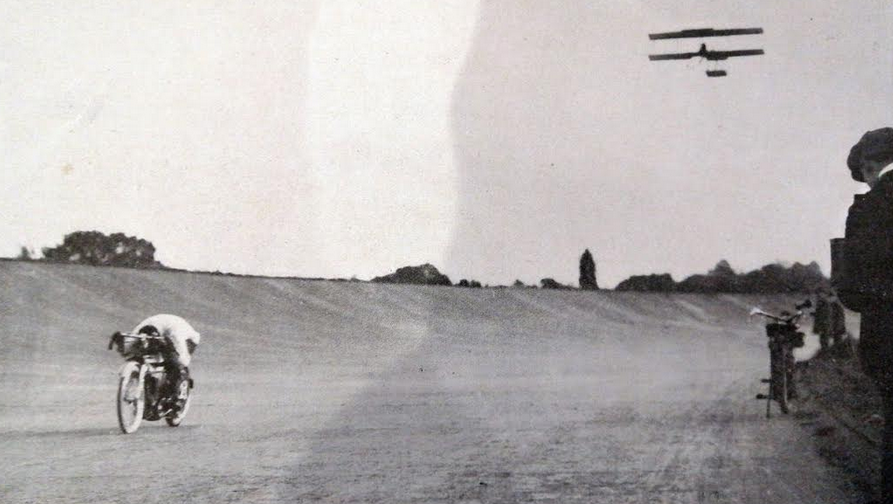
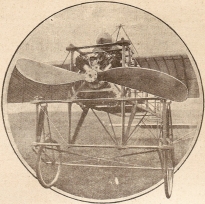

“I HOPE IN YOUR paper you will do all you can to discourage motor cycling clubs to hold their runs en masse. Motor cycling clubs, as clubs, I think should be encouraged, and runs to a given destination are desirable; but runs en mase are altogether objectional. When six motor cyclists are riding together on a dusty road the effect is sufficiently bad, but when twenty or thirty are together the road is often temporarily unuseable. Fortunately, this riding together will be restricted to a large extent owing to the discomforts experienced by the riders themselves, but on the other hand there appears to be a class of motor cyclists – as there always was a clas of cyclists – to whom dust and dirt have no terrors. I therefore trust you will do your part in bringing before motor cycling club officials the advisability of dividing up into small parties and taking different routes to the same destination when possible.”
THE YARMOUTH &DMCC speed trial at Gunton Park was one opf the first events to use electrical timing gear, courtesy of RH Williams, a Number 8 Hat who was assistant club secretary. Reel of fine cotton were stretched across the start and finish lines a foot off the ground and attached to a switch. When a bike’s front wheel hit the cotton it tripped the switch before breaking; a mile of wire connected the switches at the start and finish.
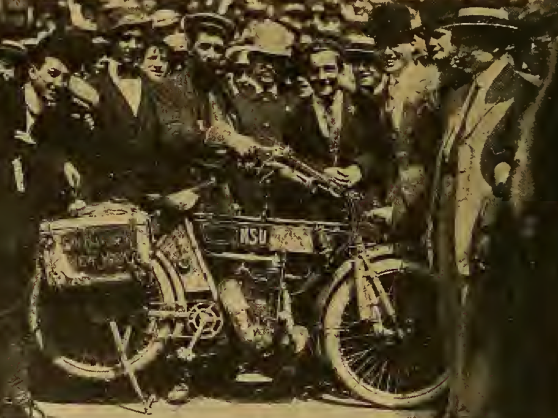
“Tanned and burned by wind and sun, permeated with the dust of many States, his clothing torn and his body sore from rough roads and innumerable falls, William Streiff, riding a 4hp two- speed NSU motor cycle, rolled into New York.” He had ridden across the USA from San Francisco, covering 3,734 miles in 28 days and two hours, averaging about 130 miles and 13 hours a day in the saddle. “Many times Strieff had to use his compass for direction, for signboards are an unknown quantity in that region. While travelling by compass he struck due east, and cut through wire fences, which he alwEiyt mended. Many Indians—civilised, of course were passed, but they made no attempt to bother him.”
THE FINAL ACU quarterly trial of the year, and the last one to use the Uxbridge-Banbury-Uxbridge route, was beset by foul weather with cold, torrential rain and mud to dampen riders’ spirits. Of 42 starters 10 dropped out due to the weather or mechanical mishaps; only 11 solos and two passenger machines made non-stop runs. When the points for the year’s trials were totted up WF Newsome (3½hp Triumph) and F Philipp 3½hp Scott) Scott had tied for first place, scoring 710 points from a possible 720. Third placed was W Pratt (3½hp P&M).

THE ARMSTRONG Triplex Gear Co beefed up its three-speed bicycle hub to suit lightweight motor cycles from 1½-2½hp (it was felt that bikes from 3½hp upwards simply didn’t need three gears). The hub incorporated a metal-to-metal multi-disc clutch running in oil.

OFFERED IN exchange for a motor cycle in a single issue of the Blue ‘Un were: A pony and harness, pianos, piano players, a ‘bull bitch’, lathes, bicycles, a ‘ralli trap’, bedroom and drawing room suites, two- and four-seater cars, a small locomotive, graphaphone, cinematograph and lantern attachment, camera and a magnifying glass.
WE HAVE HAD to ride in some fairly ‘parky’ winds, and for the benefit of the road fraternity generally I should like to press home the value of carrying small muffs rigidly fixed to each end of the handle-bar. Several pairs of gloves interfere with the manipulation of the levers and oil pumps, without keeping the hands really warm; a short muff mounted just in front of each handle enables us to keep our hands warm without spoiling our grip, and I for one regard these fitments as essential to cosy riding in winter.”
INDIAN FITTED leaf-spring suspension up front which became closely identified with some of its most popular models for decades to come. The new set-up improved handling significantly–the firm reckoned the high speeds achieved by the latest 7hp Indians at Brooklands would have been impossible without it.
“THE FAIR SEX are at last tumbling—if one may accuse them of anything so ungraceful—to the possibilities of the motor bicycle from their point of view…The ideal ladies’ machine must exhibit three main features, viz., light total weight, marked ease of starting and high hill-climbing efficiency…whole batta- lions of girls will take up the sport in days to come; and their day will come when they can get an 80lb machine with a free engine and a variable gear…Such a specification would appeal to many girls who can never hope to be athletes…The lightweight will relieve slender wrists of exhausting strains…Before we are much older we may see a ladies’ motor cycling club and even a ladies’ six days trial…” But what if a lady rider encountered a mechanical problem? The Blue ‘Un was reassuring: “Are there not usually friends or brothers who will undertake the little adjustments which would soil dainty fingers?”
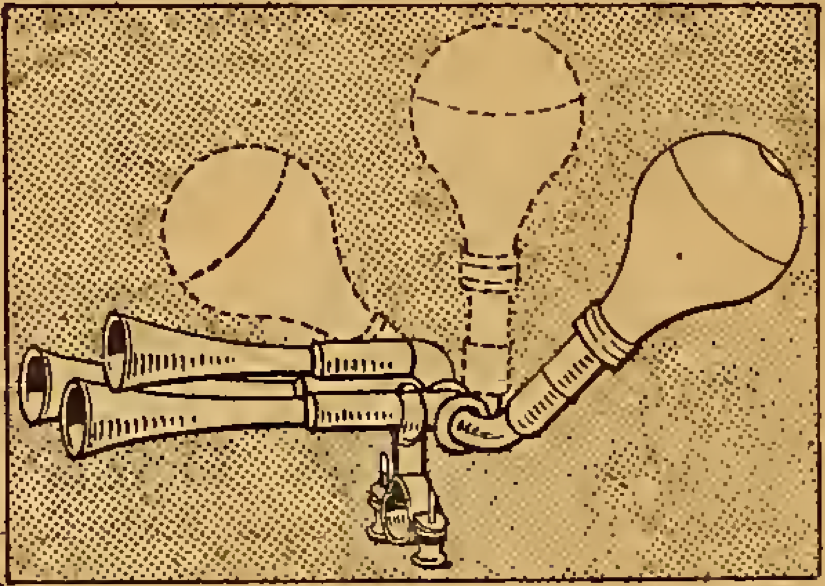
“MR F UMPLEBY, Manningham Lane, Bradford, has recently built an ingenious form of rotary engine, of a type quite unfamiliar to our readers, which combines the four-cycle principle with the advantages of a turbine…In the outer casing A is bored out a heart-shaped space B, and in it revolves what is termed the piston C, which is an oval-shaped block dividing the space A into three chambers, each chamber being separated from the other by a. gaslight joint formed by the rocking shoes E E, which are pressed up against the piston by the external springs B B. The gas first enters the inlet chamber through the inlet port H in the end plate G, in which can be seen the crankshaft ball bearing and the slot through which the slotted disc or throttle J may be controlled. The slotted disc I is the inlet valve attached to the crankshaft F…the piston divides the cylinder into three chambers, and in each one of; these the cycle of operations is continuing, and each cycle takes up 75% of the revolution, and there is an impulse every revolution. It will be seen that there is a distribution gear for working the” valves, and this gear causes the piston to make three revolutions to two of the outer casing.” Was Mr Umpleby’s Petrol Turbine just a curiosity? Or was this the birth of the rotary engine, 20 years before Felix Wankel patented his design and 45 years before a Wankel prototype ran?
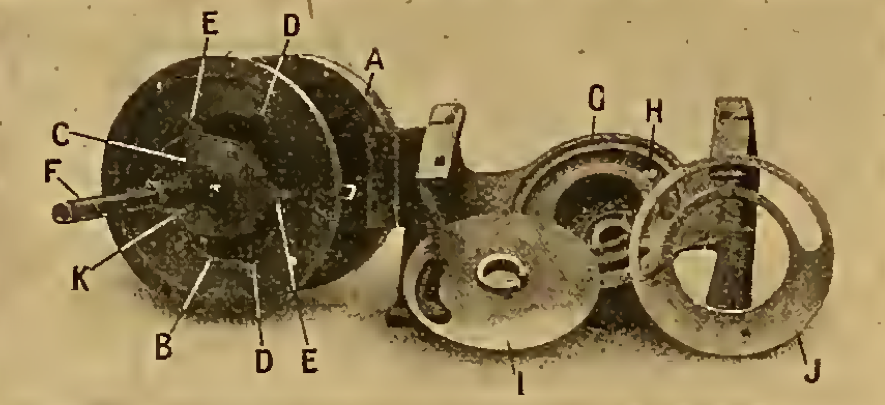
ALBERT CATT of the Northamptonshire MCC covered 1,882 miles in six days on his 3½hp Triumph (92½ hours actually in the saddle), breaking the six-day endurance record that had been set by the Blue ‘Un’s Ixion on his Advance in 1905. The Motor Cycle said: “We have great pleasure in congratulating the intrepid rider on successfully accomplishing the sternest feat of pluck and endurance yet recorded in the annals of motor
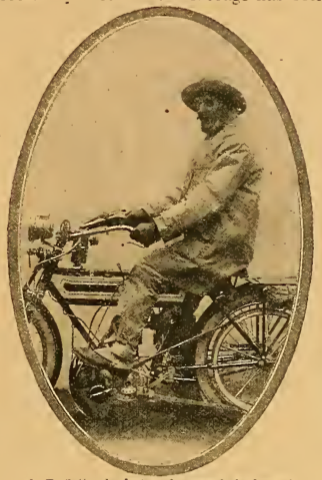
cycling…The weather throughout the, week was atrocious. Skiddy roads were the smallest handicap with which the record-breaker had to contend, although he probably did not enjoy more than 100 miles of dry going. Snow, sleet, ice, rain, hail, fog, cold, gales, and darkness combined to render the task positively stupendous, yet but for an inexplicable mishap at 8am on the last day, the total mileage would probably have touched the 2,000 mark.” The run was made in November; each day’s run began and ended in darkness. No spare belt was carried or needed and, remarkably, the Triumph didn’t suffer a single puncture. A valve broke at the 720-mile mark (and was replaced at the roadside), there were problems with mud and water in the carb and some fluff in an oil line caused a seized big end that was sorted at a village forge. “The only modern achievements which are worthy to rank with the Triumph’s performance are sundry long-distance cross country rides performed in America and the colonies; and few of these can claim accurate verification. The ride was conducted with every consideration for the public. Mr Catt was forced into a ditch by a recklessly driven trap, but his own driving was unexceptionable. He charged a cart near Coventry on the fifth day, but the cart was standing broadside across the road in the dark without its lamps being lit. Luckily, a bent footrest was the only result of the accident…” The Mayor of Northampton presided at a celebration dinner in The Stag’s Head where Catt was presented with a huge inscribed silver bowl from his club and a silver cup and gold medal from Triumph. This wasn’t Albert’s only six-day trek; for more long-distance yarns, including a jaunt round the coast, see the End-to-End feature in 1911.
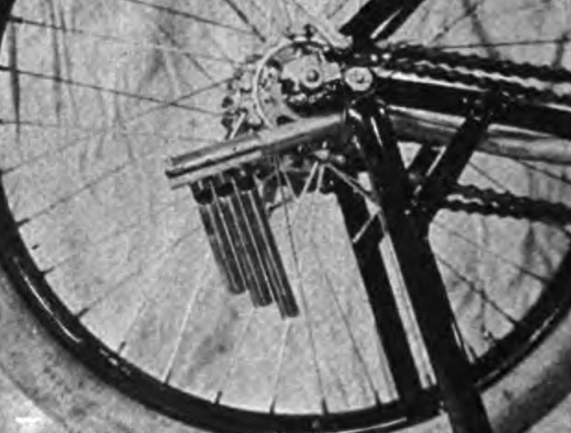
FREDDY BARNES went to Brooklands with the 3½hp Zenith Gradua that had taken him to victory in numerous hillclimbs. He climbed the 1:4 test hill in 12.5sec, beating his own record and almost equalling the 11.8sec achieved by a 65hp Napier car. Then he did some standing starts, reaching 35mph in 8sec and 42mph in 12sec.
THE BRITISH view of American record breakers remained… cautious: “De Rosier, on a 7hp Indian, made three world’s records on October 29th, viz, 1 mile in 41.2sec, 100 miles in Ihr 15min 24.4sec, and 79.88 miles in one hour. These performances were officially sanctioned timed, and judged. The strange part about it is that no such speeds have be»n accomplished on similar and even more powerful machines in this country. Is it the air?”

NEAR THE END of the year a group of enthusiasts met in the Red Lion, Truro, to form a Cornwall MCC. At the same time but far to the north the Newcastle &DMC hosted a whist drive which attracted some 60 members and a number of geordie lasses.
MESSRS WALSH and Robb of Bristol developed a water-cooled square four car engine with a rotary ‘distributing’ valve in the centre. There was talk of a smaller version for motor cycles.
“THE MOTO CYCLE Club de France is apparently no more, and there exists but the Moto Cycle Club de Paris in the Metropolis, so that at the present moment there is no body capable of organising a reliability trial, but the track is still open and a few performances on the Velodrome d’Hiver or the Pare des Princes would convince the Parisian public that English machines will stand up to their work. The French motor cycle industry “is not quite dead”, our informant tells us, but to save it the French makers must either improve their machines or, at any rate, among the more wealthy, the English maker, if he play his cards well, stands a good chance of reaping the field.”
AS AN INDICATION that motorcyclists have always had a crazy streak, no less than 71 riders left the Bell, Hounslow at 7.30pm on Boxing Day for the Motor Cycling Club’s 24 hours’ run from London to Exeter and back. Of course it was cold but it also rained most of the time, sometimes torrentially. The first retiree was Guy Lee Evans, whose 7hp Indian combo developed gearbox trouble at Salisbury on the way south (yes, the same Lee Evans who was a top-class road racer, hill-climber and record breaker). The contemporary report notes: ”Soon after leaving Salisbuiy heavy rain fell for 20 minutes;

in consequence the roads, already very bad, were converted into a horrible quagmire.” Competitor Roy Walker (3½hp Rudge) recalled: “Many new 1911 models had only been delivered to their owners a day or two before, so the engines were not run in, and got hot with the prolonged running on a low gear…The accommodation and catering at the Angel Hotel were quite good, and a two hours’ respite was very welcome. It was grisly work turning out in the wee sma’ hours for the dreaded ninety miles to Exeter. Wilton was practically under water, but there was a narrow path available between the floods. Soon after this, in a blinding storm, about twenty riders lost their way, and went chasing round and round some baronial park. This seemed to have innumerable lodge gates and roads like a maze, as they always brought us back to a steep, narrow, and skidsome hill with a kind of triumphal arch half way up it. The idea that the modern 3½hp single will climb any hill received a rude shock hereabouts, and many of us envied the rider of the two-speed

Scott, which seemed rather to enjoy single-figure gradients with hairpin bends and ploughed-field surfaces. At the end of an hour we nearly fought about which turning was the right one, but finally we struck the main road, and had only to follow the telegraph wires…Hugh Gibson’s 3½hp single-speed belt-driven Bradbury, which was minus pedals, went magnificently; the End-to-End sidecar record holder and his lightweight passenger, George Wray. want some beating as a sidecar team. Both this machine and George Brough’s had some very clever mud-shields and belt-guards… I finally reached Hounslow about half-past eight, after a vain attempt to make up time by a ‘blind’ over the frozen ruts; this nearly ended in an end-on collision with a big Daimler car which, with its dazzling head lights, was travelling the other way at about 35mph.” In the end 50 of the 71 starters made it back to Hounslow inside 24 hours to win gold medals; three more made it in 30 hours to win silver– among them was after E Kickham (2¾hp Douglas) who, after 322 miles, was seven minutes late. The rest had been beaten by the weather and mechanical mishaps.


THE SHEFFIELD and Hallamshire MCC fielded 17 riders (including five combos) in a reliability run and reported “a blizzard made the task more difficult”, but nine completed the 170-mile run on time. And 21 NW London MCC members were out on a 12-hour winter run, from Hampstead to Gloucester and back, including Birdlip Hill. Seven made it back on time.
TOWARDS THE END of the year a growing number of clubs were closing their hillclimbs to bikes with “infinitely variable gears” (which effectively meant Zenith Graduas). Ixion remarked: “Sportsmen must regret that all our hill climbs are not run on the old and characteristically English ‘let-’em-all-come-and-Old-Nick-take-the-hind most’ principle.”
“OBSERVANT MOTOR cyclists could spend quite an interesting time examining the equipment of the machines in the winter reliability runs, and many were the clever fitments to add to the riders’ comfort. Nearly all carried pocket flash lamps, and one or two had been clipped to the handle-bar in order to illuminate the route card. At least one competitor earned an electric pocket torch to direct a light on to finger posts at crossroads. Snowshoes were generally favoured, and some had gone further and fitted guards at the front of the footboards to ward off the cold. We noticed the little red reflector lamps on several competitors machines. Nearly every magneto had a protector of some description—in most cases they were completely covered, whilst extra large mudguards and flaps were quite common. Handle-bar muffs, overall leggings and storm helmets were much in evidence–surely never was there such a set of peculiarly clad men, and all sportsmen to the backbone.”
REX SET UP agencies on Germany and Russia (though the Russian agency was based in Warsaw).

NORTONS WERE flying the flag in New Zealand, winning three major hill-climbs at Saddle Hill, Timaru and Otago.
AT YEAR’S END a census in The Car covered two-wheelers as well as four to reveal a total of 76,277 bikes in England, 6,171 in Scotland and 3,966 in Wales; a total of 86,414. RAC figures indicated some 75,000 motor cycles were registered in 1909 and 65,000 in 1908.
MOTOR CYCLE exports continued to rise. In 1908-9 exports overtook imports, by the end of 1910 they were triple the 1908 figure (1908, 1,048; 1909, 1,442; 1910, 3,148). Over the same period imports had stayed roughly the same (1908, 1,340; 1909, 1,442; 1910, 1,387).
MOTOR CYCLE clubs were forming and growing. The competitions they staged were a major factor in the evolution of the motor cycles they rode, and that we ride today.



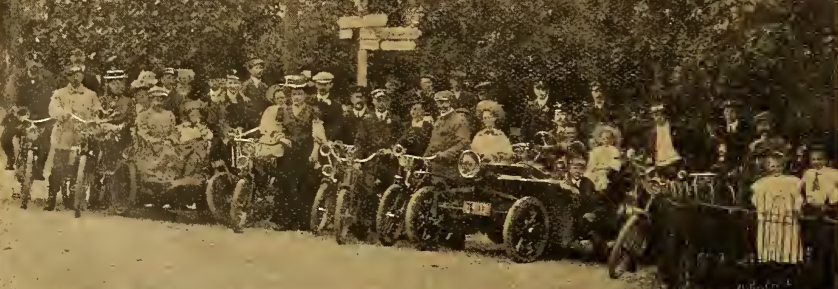

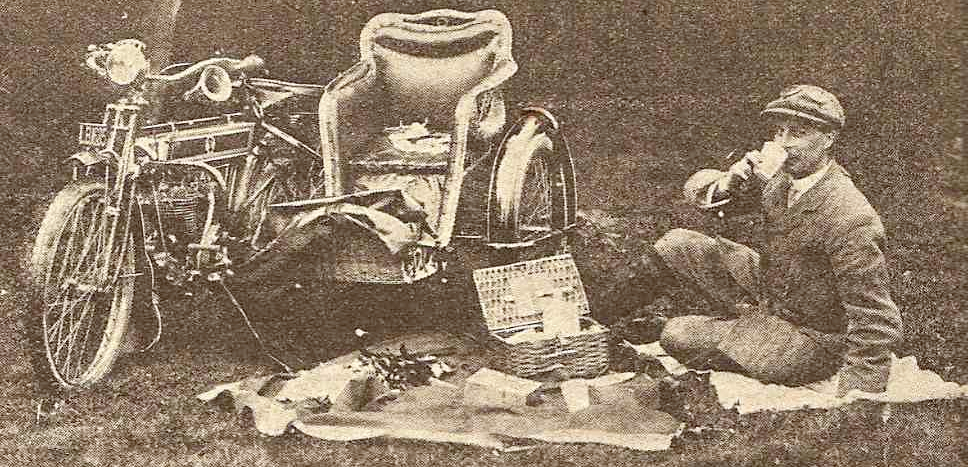

And here are some ads that deserve to be preserved…
